OPPORTUNITY AND CHALLENGE
The Story of BLM
|

|
|
AN AGENCY WITH A MISSION:
The 1970s

In light of its multiple responsibilities and the complexities of its
programs, the Bureau has long needed a Congressional statement of policy
and a modern legislative mandate.
—Eleanor Schwartz
|
AN AGENCY WITH A MISSION
The 1970s
|
|
|
Thirty years after its formation, the Bureau of Land
Management was finally granted a mission. The Federal Land Policy and
Management Act of 1976 (FLPMA) formally recognized what BLM had been
doing on an interim basis for many years:
managing the public lands under the principles of multiple use and
sustained yield. FLPMA did much more, though—it granted BLM new
authorities and responsibilities, amended or repealed previous
legislation, prescribed specific management techniques, and established
BLM's California Desert Conservation Area. The Bureau was now in the big
leagues.
|
|
Overview |
|
The road to FLPMA proved to be dramatic. Public land
issues were discussed in three Congresses, with both old and new
constituents involved in the debate. The bill was approved at virtually
the last minute in a closed door session of a House-Senate conference
committee. It is a complex bill that reflects the nation's priorities in
the 1970s. Public participation and planning were the tools provided to
make management decisions.
The first day of 1970, however, opened with President
Nixon signing the National Environmental Policy Act (NEPA). NEPA
recognized that federal actions had impacts on the environment and
required that they be analyzed before management decisions were made.
The act established protection of the environment as a national goal and
encouraged federal agencies to set up environmental education
programs.
BLM and other federal land managers at first thought
NEPA was nothing new—after all, resource specialists considered
impacts of their work as a part of their jobs. But they were wrong. NEPA
brought profound changes to BLM. Its provision for environmental impact
statements changed the way the Bureau did business.
In addition to NEPA, Congress addressed specific
environmental concerns. Legislation was passed to protect air quality
and endangered species, and was amended to strengthen protection of
cultural resources and water quality. The Wild and Free Roaming Horse
and Burro Act of 1971 radically realigned BLM's management of these
animals, requiring protection and enforcement programs.
Increased public involvement showed BLM that land
management was becoming every bit as much a social and political
activity as a scientific endeavor. Advisory boards were increasingly
used at national, state, and local levels. Public meetings and hearings
became everyday components of field operations.
Congress was asked to settle disputes among land
users by specifying land uses but, more often than not, left the
decisions to land managing agencies (or the courts). Environmental litigation
seemed to become a way of life for BLM in the 1970s, as various interest
groups filed suit under the new acts.
Under Presidents Nixon and Carter, Congress was also
asked to reorganize the Interior Department—creating a Department
of the Environment and Natural Resources. In each proposal, the Forest
Service and other Agriculture Department agencies (e.g., the Soil
Conservation Service) would have been moved into the new Department;
under Carter's proposal BLM would have been remade in the Forest
Service's image. Neither effort was successful, but President Nixon was
successful in getting his fallback position accepted—the
Environmental Protection Agency was created in 1972.
The number and type of employees in BLM increased as
the Bureau's environmental responsibilities increased. BLM's cultural
resources staff grew from one specialist at the Denver Service Center in
1970 to more than 120 (one in almost every field office) only 5
years later. Total employees in the Bureau rose from 4,300 in 1970 to
9,600 in 1980, while its budget increased from $118 million to $588
million.
In 1973, the nation was jolted by a major energy
crisis. While waiting in mile-long gas lines, millions of Americans
began to consider the nation's long-term energy needs. Although the
environmental movement never diminished in the public's consciousness,
its prominence soon gave way to concern over America's energy
future.
Despite passage of the Public Rangelands Improvement
Act in 1978, many of the Bureau's traditional constituents felt BLM had
bypassed them in a rush to embrace new public land users. The Sagebrush
Rebellion grew out of opposition to the federal government's enlarged
role in public land management. In 1979, the Nevada legislature passed a
resolution calling for state ownership of BLM public lands. Four other
western states soon passed similar legislation, but the movement quickly
dissipated with the election of Ronald Reagan to the presidency in
1980.
|
|
|
The 1970s were every bit as tumultuous—and
exciting—as the previous decade. Three new Directors served BLM
after Boyd Rasmussen: Burt Silcock (1971-73), Curt Berklund (1973-77), and
Frank Gregg (1978-81). Silcock, a career Bureau employee and Alaska
State Director from 1965 to 1971, was called upon by Secretary Walter
Hickel to handle critical Alaska issues in the early 1970s and to
continue Rasmussen's work in obtaining an "organic act" for the
Bureau.
|
|
New
Leadership |
|
Final passage of FLPMA was attained under Berklund,
who presided over a significant growth in BLM's management
responsibilities. BLM implemented a cultural resources program,
developed wilderness review procedures, and established new minerals
policies—all priority items during Berklund's
tenure—reflecting BLM's growth into a true multiple use agency.
Frank Gregg began the Bureau's implementation of
FLPMA, finalized new mineral leasing policies, and oversaw the
Bureau's efforts in securing passage of the Alaska National Interest Lands
Conservation Act of 1980.
|
|
|
A DIRECTOR'S PERSPECTIVE: 1971-1973
by Burt Silcock
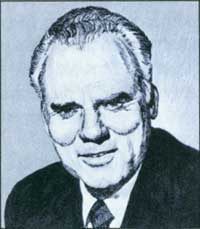
Burt Silcock (Jennifer Reese)
|
Editor's Note: Burt Silcock rose through the ranks in BLM as a
range conservationist in Billings Montana in 1948, to Alaska State Director in 1965,
and Director in 1971. In 1973 he was appointed Federal Co-Chairman of the Joint
Federal-State Land Use Planning Commission for Alaska.
As I reflect back on my career, I don't believe there has
ever been such a "window of opportunity" as existed during the 50s-60s and early
70s. The atmosphere was ripe for growth, both for the Bureau and its
employees. Finally, America was beginning to recognize and acknowledge
the value of our public lands. I am extremely proud to have been involved in this period of history, and
cherish all the acquaintances of the dedicated men and women I worked
with who laid the groundwork for today's true multiple use
management.
Little did I realize, when I started with the Bureau
in 1948, where my career would lead me. I felt I had a solid grasp of
resource problems, and the BLM employees were a real asset. However,
with all the experience I brought with me, we still had a tremendous
challenge of continuing the course of good public land management.
When I became Director, the search for a national
land use policy concerning public lands was in full swing. The Public
Land Law Review Commission had completed its study and the
Classification and Multiple Use Act and the Public Sale Act had expired.
The President had submitted a reorganization plan to Congress to
establish a Department of Natural Resources and an Organic Act for the
Bureau. The BLM had developed a long-range land use planning system for
multiple use management of the public lands.
The challenges that we faced while I was Director
were signs of a changing nation. America's demand for use and enjoyment
of public land for recreation had reached an all-time high. Off-road
vehicles (ORVs) made it possible for users to reach heretofore
inaccessible areas. Cultural, archaeological and physical features of
the landscape were being destroyed by uncontrolled use. Facilities to
provide the basic need of sanitation were rarely available and our
enforcement capabilities for desert areas did not exist. We developed
regulations for the management and control of ORV use in accordance with
the Presidential Executive Order of 1972. This finally gave BLM the
tools to control and direct this growing program.
The need for clean sources of energy to meet the
nation's demands for growth and development focused on coal, oil shale,
and geothermal steam. This had a major impact on the Bureau's energy and
minerals programs and really tested our young planning system.
The Native Claims Settlement Act for Alaska, passed
by Congress in 1971, required the most massive redistribution of land
ownership in the history of the nation. The Act provided for a transfer
of approximately 44 million acres of land to private ownership and the
withdrawal of 80 million acres of federal land for parks, refuges and
national forests. The values of these lands were previously recognized by the Bureau of
Land Management's classification process in the late 1960s, when I was
the State Director in Alaska.
The uncontrolled use of the public lands by wild
horses and burros was in direct competition with domestic livestock and
wildlife. Attempts to control this use resulted in a controversy with
the wild horse sympathizers. The Wild Horse and Burro Act of 1971 was
passed by Congress to establish a policy for management of these animals
while providing them a legitimate place on the range. We developed
procedures to provide a program for management of these animals under
the Act and setup the Adoption Program. A National Wild Horse Advisory
Council was appointed to provide federal land managers with advice based
on their knowledge and experience on this highly visible public land
use.
Under our newly formed planning system, the Bureau's
Western Oregon Management Plan was implemented July 1, 1971. This plan
met the requirements of modern legislation dealing with air and water
quality, improving the environment, protection and enhancement of other
resources located on the timber sale contract areas, construction of
roads to higher standards, protection of scenic corridors along roads,
and limiting logging adjacent to recreational sites. This new plan
resulted in an annual sale reduction of 150 million board feet. This was
due in part to environmental considerations, the destructive 1962
windstorm and the Oxbow fire of 1966.
The Environmental Impact Statement process was
refined to meet the requirements of the National Environmental Policy
Act. We initiated programmatic environmental statements on broad program
areas of coal, oil shale, upland oil and gas leasing, timber harvest,
and management of domestic livestock.
The proposed construction of the Alaska Pipeline was
a major project requiring the Bureau's workforce to develop
environmental and technical guidelines and monitoring for a safe
construction of the project. The Final EIS on the pipeline was completed
in March 1972. Environmental stipulations to manage construction of the
pipeline were far more stringent than any previously established. This
required extensive cooperation and coordination with industry, the State
of Alaska, and the federal agencies involved.
During this period of time we expanded the role of
Eastern States Office. It had been serving as a land office for many
years and the need for a full service office in that region of the
country was rapidly growing. This required a new State Director and
supporting staff.
I can't stress enough the admiration I had for the
BLM workforce then and now. Also, the relationship that existed between
my office and the Secretary of the Interior made for extremely pleasant
working conditions. I always felt that Secretary Rogers C.B. Morton and
Assistant Secretary Harrison Loesch would back us on tough decisions and
I have many examples where they stood right with us.
I'm still interested in public land management and
try to stay involved by volunteering for projects which I enjoy. It was
an interesting and sometimes hard ride from my early years in Billings,
Montana, but I feel fortunate to have had the opportunity to complete
the trip without getting bucked off.
|
|
|
NEPA: A NEW CONSCIOUSNESS
|
|
|
The same year Americans landed on the moon, Congress
passed the National Environmental Policy Act of 1969 (NEPA). Senator
Henry Jackson was instrumental in getting the act through Congress. In
the late 1960s, a symposium he organized recommended that Congress
establish a national policy on environmental quality. There was even
discussion on the Hill on whether Americans should have a constitutional
right to a clean environment.
Attesting to the strength of the environmental
movement, NEPA passed the Senate unanimously. President Nixon waited a
few days so he could sign the bill into law on January 1, 1970. Other
than placing environmental protection on a par with motherhood and apple
pie, few knew what the act would bring.
|
|
|
NEPA required federal agencies to consider the
potential impacts from proposed major actions and created the Council on
Environmental Quality (CEQ) to implement its provisions. According to
Ron Hofman, then acting Chief of the Division of Planning and
Environmental Coordination, the idea of environmental impact statements
(EISs) was added to the act at the last minute to provide an
"action-forcing mechanism" for agencies to (1) discuss their actions
with the public and with state and local governments, and (2) to
formulate management alternatives after extensive on-the-ground
evaluation.
|
|
Council on
Environmental
Quality |
|
Once draft statements were presented to the public
for review and comment, final statements were filed with CEQ. The
Interior Department established the Office of Environmental Project
Review to direct and approve EIS activities in the various bureaus.
Implementation of NEPA in BLM was assigned to Irving
Senzel, Assistant Director for Lands and Minerals. To handle this new
and rapidly growing workload, the Division of Program Development was
renamed the Division of Planning and Environmental Coordination
(P&EC). Under Hofman, the Division hired several new employees,
including a sociologist, an economist, and an environmental education
specialist, to review impacts on the "human" as well as the physical
environment. P&EC staffs were also established in State and District
Offices. For major projects, interdisciplinary EIS teams were set
up.
Lacking guidelines from CEQ and the Office of
Environmental Project Review, BLM first had to clarify what a "major
federal action" requiring an EIS was. The Bureau also needed to decide
when other kinds of environmental analyses would be appropriate. The
idea of doing environmental assessments (EAs) originated in BLM and was
later picked up by the Department and incorporated into CEQ guidelines.
P&EC issued a BLM Manual on NEPA requirements in 1971 that was used
as a model by other agencies.
|
|
|
IMPLEMENTING NEPA IN BLM
by Ron Hofman
Associate State Director, California State Office
Editor's Note: Ron Hofman was in charge of the
Division of Planning and Environmental Coordination in Washington when NEPA passed, and
continued in that post until 1976.
I guess it was a case of being in the right place at
the right time. In 1970, I was given the job of implementing NEPA, which came to have a dramatic
impact on the entire organization.
It seems like I had been preparing for NEPA during my
entire career in BLM. When I began as a forester in Colorado in 1958, we
didn't have a specialist for every program—so I had to learn about
the range program, wildlife issues, recreation, fire, soil and
watershed. BLM was really in the job of managing all these resources
together as systems. So when NEPA required us to look at the effects our
actions were having across the board, I and other land managers could relate
to that concept. The main issue was to fit this ecosystem approach into
the Bureau's customary narrow way of doing business, in the
program-by-program channels of BLM's policy, procedure, budget.
The answer to the program "blinders" problem was to
initiate an interdisciplinary approach to analysis and problem solving,
while preparing environmental impact statements or environmental
analysis documents. Here again the tendency was for specialists to
individually start these documents. We had to put together some fairly
specific training sessions, so after issuing BLM manuals on NEPA, my
staff and I visited each state to conduct this training. Its basic
premise was to assemble specialists on an interdisciplinary team, all
working together to conduct the analyses. The Bureau's policies and
procedures for conducting analysis of environmental impacts were among
the first to be formalized by federal agencies.
Another aspect of NEPA which I think the Bureau
responded very well to, was the requirement for looking at impacts on
the "human" environment. The Bureau understood that a lot of what we
did, especially in grazing, logging, and mineral development, would
continue to have a large impact on small western communities and their
cultures. It was with some pride that I hired the first sociologist in
the Bureau in 1972. It was also nice that she was a woman and that she
was black. Many more people from the social sciences were hired
throughout the Bureau to respond to NEPA, and these folks contributed to
the learning and capability of the organization. It was a major growth
step for us in understanding ourselves as a multiple-use agency.
There was a down side to implementing NEPA, though.
The legal challenges to projects forced agencies, including the Bureau,
to think in the defensive terms of legal adequacy of documents. This
took away from the initiative and motivation of the Bureau and weakened
our opportunity to build on our ecological skills. On balance, however,
NEPA was great for BLM. It started us thinking in ecosystem terms, using
interdisciplinary teams, adding social science skills, and enhancing
peoples' knowledge of the environment.
|
|
ENVIRONMENTAL EDUCATION
by Ron Hofman
Associate State Director, California State Office
Earth Day Number One, April 22, 1970, was an exciting
time. Elementary schools, high schools, junior colleges, and
universities were calling us asking for speakers to talk about the
environment. How was it being threatened? What could the public do about
it?
Secretary Hickel established a Youth Task Force to
respond to questions and issues that young people were raising about the
quality of the environment. Linda Bemis in the Division of Planning and
Environmental Coordination was BLM's representative on the Task
Force.
The National Environmental Policy Act (NEPA) passed
in response to an overwhelming national concern about the environment.
It had provisions for providing citizens with a better understanding of
the environment and how to protect it. This authority, together with the
demand from the public, gave BLM the opportunity to respond and serve
the public in a positive way.
Working with the Oregon State Office, we lined up two
college biology majors to draft a teachers guide which could be used at
the elementary school level. The idea was to provide teachers with
lesson plans which would get students to observe and learn about the
environment in the classroom and in the school yard. This draft,
finalized by Linda Bemis, was tested in the Charlottesville, Virginia,
school system with much success. Later, it was adopted as required
teaching material in the entire elementary school system in the State of
Pennsylvania. The final teachers guide was called "All Around You."
We also came up with the idea of using public lands
as "Environmental Study Areas." This was accomplished by getting some
district managers excited about the idea and then directing them to do
it in annual work plan directives. A DM would typically hire a local
6th-grade science teacher to work as a summer temporary, and using a
good BLM site near town, the teacher would develop a week-long
environmental science curriculum. Once the school year started, the
teacher would schedule sessions on the BLM site and use BLM specialists
to help teach.
Students learned a great deal about biology, about
the Bureau, and especially about the importance to their local community
of maintaining a healthy environment on the public lands. Among others
we established highly successful environmental study areas at Casper,
Boise, and Billings and were gratified at the recognition and positive
support BLM received from local communities.
The idea of an environmental education program
continued through the mid-1970s in BLM and the Forest Service. It was a
major advance for BLM because it caused the public to realize the
importance of the public lands and resources in the lives of people and
in western communities, and the importance of maintaining the health of
public land ecosystems. I am very proud of the Bureau's work in
environmental education. Perhaps in a different form and context, the
idea and the work remains out there in BLM today.
|
|
|
BLM also had to decide at what level of a program it
needed to do an EIS. Allotments, resource areas, districts, states,
regions, and nationwide programs were all considered. When BLM needed to
establish national policy, it wrote a programmatic EIS. For important
on-the-ground activities, field offices wrote EISs. BLM soon realized it
would need to prepare a "hierarchy of EISs," according to Hofman, at
different levels of the organization.
|
|
|
Oil and gas leasing statements were prepared at the
state level when decisions were reached to offer a certain number of
acres for lease. BLM, however, never knew how many wells would actually
be developed; it therefore prepared environmental assessments for each
site developed and imposed protective stipulations for sensitive areas.
For geothermal steam resources, BLM estimated field sizes, came up with
development scenarios, prepared an EIS, and then did EAs on actual
development.
|
|
Hierarchy of
EISs |
|
The range program started preparing a programmatic
EIS in 1972 to address Bureauwide range concerns and to establish
national policy for the program. BLM's coal program staff analyzed
impacts at a regional level when regional leasing decisions were reached
but wrote programmatic EISs to examine potential impacts of new federal
leasing policies (see Minerals).
Many in the environmental community found NEPA a
convenient tool for asserting their criticisms of BLM and used it in
attempts to modify BLM's management of the public lands. When BLM
completed its programmatic EIS on the range program, it was sued by the
Natural Resources Defense Council (NRDC) for not considering the impacts
of local actions by preparing local-level statements (see Range). If the
Bureau prepared local statements that were not grouped into a
programmatic EIS, it was also criticized.
BLM also reviewed EISs prepared by other agencies.
Its workload was often quite heavy because the Bureau had assembled a
wide variety of expertise to handle NEPA requirements. BLM learned a
painful lesson reviewing the Alaska Pipeline EIS. Several BLM reviewers
were critical of the statement, and word of the criticism was picked up
by columnist Jack Anderson. The Bureau soon learned if it could
criticize other agency EISs, it could expect the same in return! An era
of "politeness" soon developed in which BLM restricted EIS reviews to
areas it was directly responsible for.
|
|
|
Environmental education was one of the most positive
outgrowths of NEPA. The net result of NEPA on BLM, however, was to cause
it to consider its actions in a new light. Examining the cumulative
impacts of its actions fostered an ecosystem approach to land
management—and strengthened BLM's multiple use philosophy. While
other legislation focused on specific resources, NEPA asked land
managers to look at all of them together. Out of this developed an
interdisciplinary approach to solving problems. According to Ron Hofman,
NEPA put BLM's decisionmaking process into a "holistic context" by
having the Bureau consider ail resources equally.
|
|
Multiple Use
Concept
Strengthened |
|
In the early 1970s, funding to prepare EISs was only
slightly increased; BLM had to divert time and effort from other
activities to handle the increased EIS workload and to stipulate
mitigation of adverse impacts for actions that were approved. However,
it soon became clear that NEPA requirements had to be met. Thousands of day-to-day
actions—permits, leases, and licenses—depended on the
completion of environmental assessments and statements. BLM's program
work would have come to a stop if funding for NEPA work wasn't
increased. In the end it was, with Bureau appropriations almost doubling
(accounting for inflation) by 1980.
NEPA also had much to do with the increasing
diversity of BLM employees. Retired State Director Clair Whitlock
recalls that BLM's first "Cauldron"—a Bureauwide employee
orientation program held in Reno, Nevada—was attended by 60 to 70
people almost evenly split between range conservationists and foresters,
with only a few wildlife biologists and women represented. In 1976, two
sessions of the Cauldron were held; 56 occupational skills were
represented, including marine biologists and cultural resource
specialists, plus many more women and minorities.
|
|
Diversity of
BLM
Employees |
|
For the public, NEPA served to heighten awareness of
resource interrelationships in natural systems. According to natural
resources professor Sally K. Fairfax, NEPA became the "cornerstone" for
the environmental movement's participation in government decisionmaking.
But this participation was to be increasingly—and
unexpectedly—expressed through litigation. While NEPA had a
decidedly positive influence on BLM, according to Ron Hofman, "its use
as a legal playground took an edge off its grand vision."
|
|
|
THE FEDERAL LAND POLICY AND MANAGEMENT ACT OF 1976
|
|
|
FLPMA is a complex, detailed act that incorporated
provisions recommended by the Public Land Law Review Commission (PLLRC),
the Interior Department, and individual members of Congress. Getting
both houses of Congress to consider and pass an "organic act"
establishing policy for the management of BLM lands after PLLRC issued
its report in 1970 was a monumental undertaking. Bills were introduced
by the administration, the House, and the Senate in the 92nd, 93rd, and
94th Congresses. BLM employees had much to do with the eventual passage
of FLPMA, thanks to the continuing support of Directors Rasmussen,
Silcock, and Berklund, and of the Department under Secretaries Walter
Hickel and Rogers C.B. Morton.
|
|
|
Bureau employees played key roles in writing the
administration bill: Mike Harvey, Chief, Division of Legislation and
Regulation, and Eleanor Schwartz, who later took the job, drafted the
legislation and, with Associate Director George Turcott, "sold" it to the Department
and the Congress. Irving Senzel (Assistant Director, Legislation and
Plans) was the "brains" and editor-in-chief of the bill, according to Harvey,
while Bob Wolf (Assistant to Director Rasmussen) analyzed the PLLRC
report.
|
|
BLM
Employees
Play Key
Roles |
|
"My first job was to get and keep strong support from
the Department, the Office of Management and Budget, and the Council
on Environmental Quality, which in those days was a key player in the
administration. My second job was to get and keep strong support from
Congress," said Harvey, who left BLM in 1973 to take a job with Senator
Jackson, Chairman of the Interior Affairs Committee.
|
|
|
BLM'S RESPONSE TO THE PUBLIC LAND LAW REVIEW COMMISSION'S REPORT
by Mike Harvey
Editor's Note: Mike Harvey began his career with
BLM in 1960. After receiving a law degree from Georgetown University,
he became a staffer for the Public Land Law Review Commission. Harvey
returned to BLM in 1968 as Chief, Division of Legislation and Regulation,
and in 1973 became Chief Counsel for the Senate's Committee on Energy
and Natural Resources.
On June 20, 1970 the Public Land Law Review Commission
(PLLRC) presented its long-awaited report to President Nixon. This
event triggered a response by BLM that led directly to another long-awaited
event: enactment of an "Organic Act" for the public lands administered by
BLM, the Federal Land Policy and Management Act of 1976 (FLPMA).
All of us in BLM knew the PLLRC study (originally
due in 1968) had been used as an excuse to delay much needed modernization
of the public land management mission and authority of BLM. While the
Report, containing over 300 recommendations, covered all federal lands,
its greatest significance was for BLM. Other agencies had clear statutory
mandates. BLM was the primary target of the Report and everyone knew it.
We wanted a rapid and reasonable response so no one
could speculate about or misunderstand BLM's views on the issues. Our
response also had to be factual and analytical so BLM could establish
the basic legislative parameters that would gain secretarial and
presidential approval and significant public and congressional support.
By July 8 we had critiqued the Report and by July 17
we submitted our initial analysis to the Secretary. Within the next 5
months the Bureau prepared a 250-page detailed analysis, but our initial
analysis identified the major themes and principles we thought should be
adopted. At the same time, BLM was implementing the decision by
Secretary Hickel and Assistant Secretary Loesch to being modernizing
public land laws and regulations.
On July 2, 1970 the Director stated, "This work is
obviously of utmost importance to the future management of the public
lands and resources administered by BLM. It must be given a very high
priority..." Only July 20, 1971, the National Resource Lands Management
Act was submitted to Congress. Secretary Morton did not exaggerate when
he told Congress, "This bill represents an historic proposal. The
Department is proposing legislation which, for the first time, would
state the national policies governing the use and management of 450 million
acres of the public domain..."
Three of us put both efforts together: Irving Senzel,
Assistant Director Legislation and Plans; Bob Wolf, Assistant to the
Director; and me. First we needed strong support from the Department,
OMB, and the Council on Environmental Quality, a key player in the
Administration. Second, we needed strong support from Congress. With
extraordinary support from Secretaries Hickel and Morton and Assistant
Secretary Loesch, the first task was relatively easy. The administration's
1971 proposal was the product. The second task took 5 more years and I
had to leave BLM and go to the "Hill" to get it done. The final
congressional action approving FLPMA—Senate passage of the
Senate-House Conference Report—came on my 42nd birthday: October
1, 1976. What a birthday present!
|
|
|
The administration's bill, the "National Resource
Lands Management Act," was introduced in the
Senate in 1971. This bill focused exclusively on
BLM, requiring it to inventory public
land resources, giving priority to areas of critical environmental
concern (ACECs). The bill was not considered by the full Senate and was
reintroduced in the 93rd Congress. The Senate declined to consider it,
instead passing a bill introduced by Senator Henry Jackson. The House
took no action on either bill.
|
|
Administration
Bill |
|
Jackson's bill was reintroduced in the Senate in the
94th Congress. It differed from the administration's bill "sometimes
with only subtle changes or differences in emphasis," according to
Schwartz. Like the administration bill, it authorized management of
BLM's national resource lands under the principles of multiple use and
sustained yield, and called for a return of fair market value to the
government for the use and sale of its lands.
|
|
|
Jackson's bill contained provisions on inventory,
planning, public participation and advisory boards;
authorities for law enforcement; and
provisions for sales, exchanges, and acquisitions
of land. The bill called for
a working capital fund to be established in BLM and for a land use plan
to be completed on the California Desert. It also
contained amendments to the Mineral Leasing Act of 1920 to increase the
percentage of revenues paid to the states, provisions for mineral impact
relief loans and oil shale revenues, and requirements for the
recordation of mining claims. This bill finally passed the Senate on
February 25, 1976.
|
|
Senator
Jackson's
Bill |
|
The House of Representatives took a different
approach. In 1972 the House Interior and Insular Affairs Committee drafted
a bill, the "National Land Policy, Planning, and Management Act,"
incorporating many of PLLRC's recommendations. The bill proposed uniform
land use planning and management activities for all
federal land managing agencies but was not reported out of committee in time to be
considered by the full House.
|
|
House Bills |
|
In its next session, Congressman Wayne Aspinall was
absent, having lost a primary election. Under Representative John
Melcher of Montana, the Subcommittee on Public Lands rewrote the House's
legislation, following a lengthy series of meetings (about 68 in all) to
discuss public land issues. A bill was not completed in time to be considered by
the full House in the 93rd Congress, but was introduced in its next
session.
The "Federal Land Policy and Management Act" was
similar to Senator Jackson's bill but had provisions relating to both
BLM and Forest Service lands regarding grazing fee formulas, leases and
permits, advisory boards, and wild horses and burros. The bill also
created the California Desert Conservation Area and granted the Bureau
law enforcement authority.
By this time, Tim Monroe succeeded Irving Senzel as
Assistant Director for Legislation and Plans and, under Director Curt
Berklund, continued the Bureau's work with the Hill to clarify questions
on BLM's management activities and legislative needs for the public
lands.
|
|
|
HOW FLPMA PASSED
by Eleanor R. Schwartz
Division of Legislation and Regulatory Management
By August 1976, a comprehensive act relating to the
management of public lands had been passed by each house of Congress.
The Senate disagreed to amendments made by the House and requested a
conference. Conferees were appointed and Congressman Melcher was elected
chairman. Because many primaries had been scheduled for early September,
the first meeting of the conferees could not be held until September
15.
The first difference addressed by the conferees was
the title of the Act. The House called it the Federal Land Policy and
Management Act of 1976, while the Senate called it the National Resource
Lands Management Act. The Senate conferees deferred to the House on the
title and on the term to be used for BLM lands—public
lands—although they felt it was a confusing term.
And so it went. The conferees met four times between
September 15 and 22. Most issues were resolved rather easily but four
issues proved so difficult that they almost killed the bill. The Senate
conferees objected to the House provisions on grazing fee formulas,
10-year grazing permits, advisory boards and permits, and wanted a
requirement that mining claimants apply for patent within 10 years of
recording claims. The House conferees objected to that.
Before the end of a 5-hour session on September 22,
Senator Metcalf of Montana offered a compromise package in which grazing
fee provisions were deleted, all grazing leases would be for 10 years,
grazing advisory board functions would be limited to recommendations for
expenditure of range improvement funds, and the Senate language on
mining claims would be applicable only to claims filed after enactment
of the Act, not to pre-existing claims.
The conferees could not agree on the package that day
but agreed to meet again on September 23rd, just in advance of the conference on the
National Forest Management Act of 1976. Substitute compromises were offered by a House and
Senate conferee but both were rejected. Chairman Melcher adjourned the conference saying he
saw no point in prolonging the meeting. At that time, hopes for the enactment of a
land management act for BLM were dim.
The 94th Congress was in its last-minute rush before
adjournment. But as with many pieces of landmark legislation, a
compromise was reached at the eleventh hour. On September 28th
Congressman Melcher made a final effort to reach a compromise. He called
a meeting for 5:30 p.m. that evening. Very few persons, other than
conferees and staff, were permitted in the conference room. Within a few
minutes of coming together, the conferees took a break. Word spread
among the many persons filling the corridors that the meeting was going
badly. However, when the conferees reassembled at 7:00 p.m., those
present voted almost immediately for the compromise suggested
earlier.
In keeping with its somewhat stormy and cliff-hanger
history, the conference report was passed by the House on September 30th
and by the Senate on October 1st, just hours before the 94th session
ended. The Act was signed by the President on October 21, 1976.
|
|
THE FLPMA TIGHTROPE
by George Turcott
Editor's Note: BLM put a great deal of effort into
getting an "organic act." Former Associate Director George Turcott has another
perspective to tell in getting FLPMA passed. Mr. Turcott began working for BLM as a range
conservationist in Elko, Nevada, in 1950. He served as a district manager in Canon City, Colorado,
and Chief, Resource Management in Montana before moving to Washington in 1964. Mr.
Turcott was Associate Director from 1972 to 1979.
During the waning weeks of the 94th Congress,
senators, representatives, and committee staffs worked to fashion a
compromise acceptable to both Houses. The final hurdle, a point on
grazing fees, came late one afternoon. The conferees couldn't rewrite
the language or make compromises, even though some of the other
compromises in the bill were contradictory. The final vote called by
the joint chairman of the conference came out a tie, which in the
legislative process is non-passage—you have to have a majority of
both the Senate and House conferees voting in favor of the
compromise.
Irving Senzel, Eleanor Schwartz, and I had been
working on the Hill with Mike Harvey trying to work out language with
these people and explain the effects of different languages they
substituted in committee. I think the lowest point in my life—or my
whole career—was the day FLPMA hadn't passed.
BLM put everything it had into getting this act. Many
of us oldtimers in the Bureau said that before we retired we wanted a
basic organic act—and not all this crossword puzzle kind of stuff
we'd had to work with for 30 years.
So here we were with six years' effort apparently
down the drain. I waited until early evening and called up Senator
Metcalf, the co-chairman of the conference for the Senate, and asked if
there was anything we could do on the grazing fee issue, where he could
call everybody back together again to make one more effort. He said no:
"all the procedures are past, George, we lost."
Senator Metcalf was very much in favor of passage, so
I tried one more angle with him. I said, "well can we work some language
in there about some studies and a report back again?" Doing studies was,
and is, a common legitimizing technique—it affirmed we'd still
consider certain things, such as fair market value and the points
stockman were making as to cost of production and so forth. I finally
pleaded "just do it for me. Make one more try." He did. And, lo and
behold, that night we got one more vote—the one vote we needed—and
that's how we got FLPMA and the study on grazing fees.
FLPMA was expanded tremendously from the original
draft as it developed to the final. Section after section of it is as
detailed as a regulation or a Bureau manual procedure—and that's
detailed. I think it's a natural result of the pulling and tugging that
occurred in the Public Land Law Review Commission, of saying something
about one resource and at the same time providing counterbalances in
other areas of the act. It's a very detailed, difficult act and had to
undergo clarification by later Congresses.
|
|
|
The House and Senate reconciled their bills only at
the last minute in 1976, as described by Eleanor Schwartz and Associate
Director George Turcott. FLPMA's major provisions are as follows:
|
|
|
Congressional Review of Land Withdrawals—While
FLPMA provided for the continuation of all classifications and
withdrawals made under the Classification and Multiple Use Act, Section
202 also required BLM to review these actions when preparing new land
use plans. Congress was empowered to review sales of land in excess of
2,500 acres or withdrawals of tracts over 5,000 acres, as well as
decisions on principal uses of lands in areas greater than 100,000
acres.
|
|
Major
Provisions of
FLPMA |
|
By the end of the decade, BLM had taken little action
on reviewing existing withdrawals or classifications; it was preparing
an inventory of these actions and implementing new land use plans
(Resource Management Plans) in the field. Prior to FLPMA, 67 million
acres of the public lands had been formally withdrawn from the public
domain, including land for BLM and Forest Service recreation sites, land
adjacent to National Parks, land to protect watersheds, and land for
Forest Service roadside zones. Under the CMU Act, BLM had also
classified more than 150 million acres of its own lands in the lower 48
states for retention, plus an additional 32 million acres in Alaska.
Recreation and Public Purposes Act
Amendments—FLPMA amended the R&PP Act to increase the land BLM
could sell or lease to state and local governments, and it required
public participation in all decisions to dispose of lands under the
act.
Law Enforcement—FLPMA authorized BLM to hire a
force of uniformed rangers in the California Desert, but required the
Bureau to rely on local officials as much as possible through
cooperative agreements with local enforcement agencies.
Finance and Budget—FLPMA provided BLM with
long-needed authorities that made its work more efficient. FLPMA
established BLM's Working Capital Fund. It also allowed BLM to accept
contributions and donations for specific activities on BLM lands (e.g.,
wildlife habitat improvements or recreation developments) and allowed
BLM to establish service charges for applications and documents.
Land Exchanges and Acquisitions—FLPMA provided
for cash payments from the government to equalize values of exchanged
lands. It also gave BLM authority for acquisition under its land use
plans but limited the government's power of eminent domain. BLM was
allowed to use Land and Water Conservation funds to acquire public
recreation lands.
Special Management Areas—Section 202 of FLPMA
authorized BLM to identify areas of critical environmental concern
(ACECs) through its planning process. ACECs were defined as areas
"within the public lands where special management attention is required"
to protect "historic, cultural or scenic areas, fish and wildlife
resources, or other natural systems or processes...."
Livestock Grazing—FLPMA authorized a study of
grazing fees but prohibited any increase in the fee in 1977. To assure
long-term stability and use of BLM lands by the livestock industry, it
also authorized 10-year grazing permits and required 2-year notices of
cancellation. BLM grazing advisory boards were directed to advise BLM on
the development of Allotment Management Plans and the allocation of
range improvement funds.
|
|
|
A DIRECTOR'S PERSPECTIVE: 1973-1977
by Curt Berklund
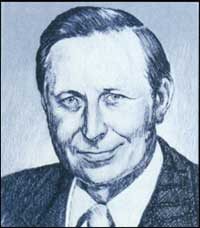
Curt Berklund (Jennifer Reese)
|
Editor's Note: Dr. Curt Berklund was retired
when he came to Washington early in 1970. He is again retired, living
in Spokane, Washington, working the financial markets and managing a
private foundation he set up to fund, among other things, scholarships
in resource management at the University of Idaho. And he still uses
a sharp eye and quick reflexes to participate in trap shooting
competitions.
The year 1973 was a threshold year for the Bureau.
Many changes were in the wind as the nation grappled with the conflicts
of Watergate and a mid-East oil embargo. As a staff assistant and
Deputy Assistant Secretary in the office of Assistant Secretary Harrison
Loesch, I had been involved with Bureau policy development and
observed the need for administrative change. When I assumed the
Director's job in July 1973, one of my first actions was to leave
Washington and meet with the State Directors. I had the highest
confidence in the State Directors and the field structure. They
needed leadership from Washington and the opportunity to carry out
the programs and be supported, not second-guessed or "rolled." The
State Directors needed someone who treated them candidly with respect.
The Bureau had few trusted constituencies. Strong
political support was needed to build a record as a professional
natural resource agency that would manage the programs on-the-ground
in the full multiple-use context. One of my desires was to establish
a way of building our credibility outside the government and have groups
and key individuals we could count on. We went to work with state and
county governments through the Western Governors and the National
Association of Counties to help build a constituency among those who
were closest to the everyday decisions BLM managers were making. Over
the years, this effort really paid dividends. We also worked on
improving our relationships with the news media.
One of the more important tasks to begin building
credibility with Congress. We organized the Bureau's first formal,
well-staffed, Congressional liasison organization; trained the people;
and gave them support and information necessary to deal effectively
with Congress. I also spent countless hours working with key members
of the Senate and House of Representatives to assure that BLM's message
was presented from a foundation of professionalism in natural resource
management. Former Members such as Julia Butler Hansen, Alan Bible,
and Wayne Aspinall, already supportive of the Bureau's mission, needed
a source of credible information. During my tenure as Director, we
effectively tripled the Bureau's budget and added skills to district
and resource area offices that were unheard of in the 1960s. I was
adamant during this period of growth that the Washington Office would
not siphon off the increased positions and budget dollars. We stayed
lean and efficient. I split energy mineral programs from the renewable
resource programs in order to give better leadership to both. This
resulted in giving our offshore and onshore leasing programs more
visibility and effectiveness. We leased more acreage (OCS and public
domain) for oil and gas exploration than had been leased previously.
We cleared lots of hurdles in setting up a geothermal leasing program,
and today a considerable amount of electricity is generated in
the West from that source.
Delegating the authority and responsibility to the
field comes to mind as one of my most notable achievements. I felt that
if the field organization had leadership, authority, and support from
Washington it would give confidence to the field managers that they were
in charge and were accountable for their program assignments. Then, they
would make their decisions with knowledge that Washington wouldn't cave
in to some real or perceived political challenge and "roll" the
decisions. This also helped the Washington staff realize their role was
to develop policies and procedures and evaluate the field manager's
performance, not dictate how the field should operate.
We won control over our NEPA implementation processes
in the Bureau previously centralized in the Secretary's office. We
accomplished it only because the professionals in the Bureau were given
the responsibility to show we could write, edit, and review our own
environmental documents. That road was rocky at times but the superb
help from countless individuals allowed us to internalize the program
and make it work as part of the overall decision process.
We worked very hard to secure approval of an "organic
act" for the Bureau. Trying to administer programs governed by over
3,000 land laws was virtually impossible. The task divided us and did
not generate the constituent support we needed. We received special
dispensation from the Department and the administration to work out the
legislation, because I had chaired the Department's committee to review
the Public Land Law Review Commission's report and make recommendations
for implementation. Former Secretary Tom Kleppe was instrumental in
providing BLM the support we needed to cut the deals and work out the
language we felt was required to formulate the legislation. We fought
hard on key issues such as wilderness review, law enforcement authority,
the California Desert National Conservation Area and administrative
provisions needed to streamline our approach to multiple-use
management. I personally opposed making the Director a presidential
appointee; however, we were able to legislate some level of protection
for the career ranks. I established the organization to implement FLPMA
and implementation began while I was still Director. We set up a
multi-disciplinary committee of Washington managers and staff and made
considerable progress in setting out basic guidelines.
One of our additional achievements was securing
congressional approval of the Payments In Lieu of Taxes legislation.
Recognized as truly "good neighbor" legislation, this helped to reduce
much of the friction with local governments in the West. We modified the
Alaska pipeline environmental statement and secured approval for the
construction permits.
We started a record search through the Eastern States
Office to identify federal coal resources in the Appalachian Region. We
were losing federal coal simply because the records were inaccurate.
This program prevented more serious criticism of the Bureau by Congress
and others because we identified the problem and sought solutions.
As I look back beyond the dozen years or so since I
had close association with the Bureau, I appreciated the opportunity to
have served. I made some close friends and learned much. While my
association with BLM is fairly limited, I still keep in touch with a few
friends and welcome calls at any time.
|
|
|
Wilderness—Section 602 of FLPMA directed BLM to
review the public lands for wilderness potential as set forth in the
1964 Wilderness Act. The act also directed BLM to conduct early
wilderness reviews on all lands designated as primitive or natural areas
before November 1, 1975.
Wild Horses and Burros—FLPMA amended the Wild
and Free Roaming Horse and Burro Act to authorize the use of helicopters
in horse and burro roundups. Wild horse and burro populations had more
than tripled since passage of the Wild and Free Roaming Horse and Burro
Act in 1971—horse numbers on BLM lands in the West were estimated
at more than 60,000, compared to 17,000 in the late 1960s.
Minerals Management—FLPMA modified the formulas
for distribution of funds collected under the Mineral Leasing Act of
1920 and the Geothermal Steam Act of 1970. It also required persons
holding claims under the General Mining Law of 1872 to record their
claims with BLM within three years. FLPMA authorized loans to state and
local governments to relieve social and economic impacts of mineral
development and directed the Secretary to develop stipulations that
would prevent unnecessary or undue degradation of the land.
|
|
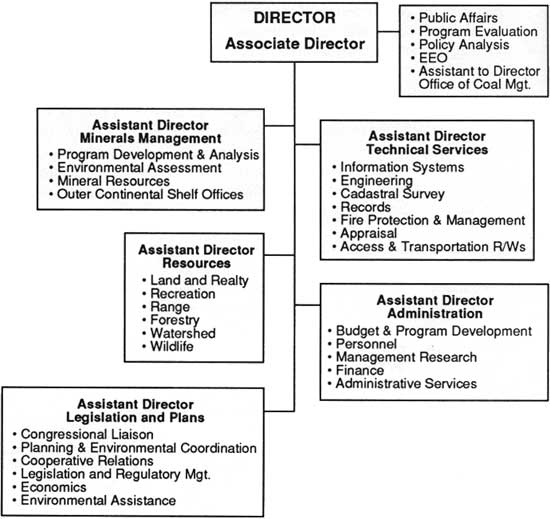
|
|
BLM organizational structure in 1977
|
|
|
Other Provisions—FLPMA established the
California Desert Conservation Area and directed BLM to develop a land
allocation plan for the area by 1980. FLPMA also repealed the Homestead
Act (except in Alaska where it was given a 10-year life) and other
settlement acts. The act also decided how future directors of BLM would
be selected—by the president, with approval from the Senate.
|
|
|
PLANNING
|
|
|
In the 1970s, systematic land use planning was
implemented in the field. Management Framework Plans (MFPs) were
prepared for 80 to 85 percent of BLM lands in the lower 48 states by
1976. Data from resource inventories was considered with economic and
social information to develop and compare management alternatives. After
holding a series of public meetings, BLM Resource Areas revised and
finalized the MFPs, and implemented them as management tools.
Ironically, NEPA had much to do with the demise of
BLM's first successful, Bureauwide planning system. Court decisions had
made EISs the Bureau's primary tool for analyzing resources, impacts,
and management alternatives on the ground—especially for BLM's
range activities. MFPs were becoming duplicative. Also, Section 202 of
FLPMA required BLM to develop a more comprehensive land use planning
system for "developing, displaying, and assessing" management
alternatives; it also directed the Bureau to strengthen its coordination
with state and local governments.
Therefore, starting in 1977, BLM began developing
Resource Management Plans (RMPs), which were to be prepared in the field
in conjunction with Environmental Impact Statements. In 1979, BLM phased
in a transition from MFPs to RMPs, whereby scheduled updates of MFPs
would be replaced by RMPs. By 1988, 61 RMPs were completed
Bureauwide—about half of the RMPs that will eventually be prepared.
The Bureau has scheduled replacement of all its MFPs by 1994.
The basic steps in completing an Resource Management
Plan are:
1. Develop public participation plan.
2. Identify issues.
3. Develop planning criteria (set standards for data
collection and formulation of management alternatives).
4. Gather information, inventory resources.
5. Analyze management situation.
6. Formulate management alternatives.
7. Estimate effects of alternatives.
8. Select preferred alternative.
9. Publish draft RMP/EIS (90-day comment period).
10. Publish final RMP/EIS (30-day protest period).
11. Monitor and evaluate overall plan.
12. Prepare activity plans.
|
|
|
FROM MFPs TO RMPs
by Robert A. Jones
Editor's Note: Bob Jones began his career with BLM in
1953. After holding lands and realty positions in Montana and the
Washington Office, he became Chief Office of Program Development—later
the Division of Planning and Environmental Coordination.
Bob Jones and his staff developed and implemented BLM's land use
planning system in the 1960s and 1970s. Indeed, Bob Jones was the
Bureau's planning system until his retirement in 1981.
One of the most interesting periods in the history of
BLM's planning program was the change from Management Framework Plans
(MFPs) to Resource Management Plans (RMPs). This is how it happened. The
Federal Land Policy and Management Act (FLPMA) requires land use plans
as a basis for public land decisions. It also requires the Department to
publish regulations specifying how these plans are to be prepared. BLM
initially felt that MFPs would meet requirements of FLPMA.
The National Environmental Policy Act (NEPA) requires
federal agencies to analyze and consider environmental impacts of all
major federal actions, and to prepare and publish Environmental Impact
Statements (EISs) when these actions significantly affect the environment.
These EISs are then filed with the Council on Environmental
Quality (CEQ). The Departmental Office of Environmental Project Review
(OEPR) directed NEPA implementation in Interior. OEPR exercised the
Secretary's authority to approve and file EISs, and was heavily involved
in the EIS process. They often specified alternatives to be analyzed and
the level of analysis. The bureaus could not approve and file EISs even
when they had authority and responsibility for the decisions involved.
These overlapping responsibilities created much tension between OEPR and
BLM.
While there was much pressure on BLM to file EISs for
proposed MFP approvals, no BLM director wanted to invite the OEPR
involvement that would follow. Instead, BLM held that where
implementation of features of many MFPs constituted a major federal
action, one EIS would be prepared to analyze the cumulative
environmental impact. We used this approach for the grazing EISs
required by a court judgment, and it worked, as far as NEPA compliance
was concerned. However, livestock grazing is widespread and influences
most public land decisions. As a result, since the grazing EIS process
was so much better publicized and drew so much wider public attention
than MFP preparation, it was, by default, assuming a major portion of
the multiple use planning role.
In mid-1977, Director Frank Gregg decided that
compliance with FLPMA required substantially upgrading the MFP process,
and that BLM should coordinate with the Forest Service, which at that
time, was revising its multiple-use planning process. We hoped to
reestablish the resource allocation decision process in the multiple-use
plan as required by FLPMA, break OEPR's hold on EIS filing authority,
and substantially upgrade the planning system to meet the needs of the
1980s, all at one time by using the same basic planning components being
developed by the Forest Service. The details would, of course, differ to
accommodate BLM needs. BLM called its product the Resource Management
Plan (RMP). The big gamble was whether RMP/EIS filing authority would be
delegated to BLM. OEPR was strongly opposed. We won! In 1979 filing
authority was delegated by Secretary Andrus thru regulations he approved
which launched the Resource Management Planning process.
|
|
|
Public meetings conducted by the employees developing
the plan are required during issue identification, development of
planning criteria, and publication of both the draft and final RMP/EIS.
Once the RMP is approved, BLM prepares more specific activity plans for
specific programs (e.g., Allotment Management Plans, Habitat Management
Plans, or others); the activities proposed in these plans must conform
to the RMP. For actions that don't, the District Manager prepares a plan
amendment, again with participation from the public.
|
|
|
MINERAL
|
|
|
Mineral policy in the 1970s was largely influenced by
the Arab oil embargo. In 1973, the Organization of Petroleum Exporting
Countries (OPEC) imposed a four-fold increase in the price of oil, and
in response to the Yom Kippur War, several countries placed an embargo
on oil exports to the United States. This action, combined with an
increased reliance on automobiles for personal transportation by the
public, created the infamous gas lines of 1973. The nation's dependency
on foreign oil had risen to 36 percent, with 10 percent coming from Arab
countries.
|
|
| Outer Continental Shelf (OCS)
Mineral Leasing Statistics 1971-1981 |
Fiscal
Year |
Gulf Coast |
West Coast |
Atlantic Coast |
Alaska |
Active
Leases |
Acres
(millions) |
Active
Leases |
Acres
(millions) |
Active
Leases |
Acres (millions) |
Active
Leases |
Acres
(millions) |
| 1971 | 1010 |
4.27 | 70 |
.36 | — |
— | — |
— |
| 1972 | 965 |
4.01 | 70 |
.36 | — |
— | — |
— |
| 1973 | 1027 |
4.33 | 69 |
.35 | — |
— | — |
— |
| 1974 | 1258 |
5.59 | 69 |
.35 | — |
— | — |
— |
| 1975 | 1607 |
7.41 | 68 |
.35 | — |
— | — |
— |
| 1976 | 1678 |
7.75 | 124 |
.66 | 93 |
.53 | 76 |
.41 |
| 1977 | 1794 |
8.67 | 121 |
.64 | 93 |
.53 | 76 |
.41 |
| 1978 | 1703 |
7.81 | 108 |
.58 | 136 |
.77 | 163 |
.90 |
| 1979 | 1757 |
8.09 | 148 |
.79 | 175 |
1.00 | 131 |
.73 |
| 1980 | 1688 |
7.70 | 142 |
.76 | 232 |
1.32 | 113 |
.57 |
| 1981 | 1941 |
8.84 | 273 |
1.55 | 128 |
.68 | 150 |
.79 |
|
ALASKA'S OUTER CONTINENTAL SHELF
OFFICE
by Edward J. Hoffmann
Manager, Alaska Outer Continental Shelf Office (1973-1978) - Retired
On a hot summer day in 1973 a cryptic message reached
me in the Arizona State Office from Ed Hastey approving my reassignment
to Anchorage as head of a newly established Alaska Outer Continental
Shelf Office. After spending a decade in Alaska in the '50s and early
'60s, the opportunity was most welcome.
The initial charge was to assemble a small
multi-disciplinary team to begin assessing the probable environmental
impacts of exploratory oil and gas drilling in federal waters off
Alaska. The Arab oil embargo and the administration's ensuing Project
Independence quickly changed the mission to a full-blown effort with
responsibilities ranging from environmental assessment to actual leasing
of offshore tracts for exploratory drilling.
This unique program required specialists with unique
disciplines—oceanographers (chemical, physical, geologic,
biologic), paralegals, petroleum engineers, economists, computer types,
geographers. There were also some garden-variety
skills—administrative types, natural resource specialists and the
all important clerical positions.
The first Alaska Outer Continental Shelf (OCS) sale
was conducted for tracts in the Northern Gulf of Alaska on April 13,
1976. Preparations for the sale surfaced major objections from state
government and Native (Indian) groups. There was a good bit of
give-and-take before the sale came to being—accommodations were
made on both sides. About $1.75 billion was offered in bids, with
accepted bids netting $571,900,000 to the Treasury. Disappointingly, no
discoveries were made during exploratory drilling. The staff received a
unit citation from the Secretary of the Interior for the excellent work
done in bringing to reality the first sale in a frontier area.
The second and final sale of my tenure was in Lower
Cook Inlet. It netted over $211 million in bonus bids to the Treasury.
Again, no commercial discoveries resulted from exploratory drilling.
As my tenure began winding down, we were negotiating
with the State of Alaska to hold a joint state-federal sale in the
Beaufort Sea off Prudhoe Bay. These negotiations were complex, involving
disputed ownership of the seabed. The Eskimos were greatly concerned
that any further industrialization of their areas would adversely affect
their subsistence way of life. Finally, an agreement was reached and the
sale consummated well after my retirement in August 1978.
The OCS offices, while within BLM, were unique in
that they were responsible to the director rather than a state director.
Since the programs were highly visible, politically sensitive, and
controversial, the Office of the Secretary took a more than casual
interest. The OCS offices eventually were transferred to Minerals
Management Service.
In retrospect, the 5 years I spent as Manager of the
Alaska OCS office were the highlight of a varied career spanning over
three decades. It was especially gratifying to have had the opportunity
to gather a highly motivated crew from a wide variety of disciplines in
an interesting and controversial program.
|
|
|
President Nixon reacted to the situation by
announcing Project Independence on November 7, 1973. The project called
for making the U.S. self-sufficient in energy by 1980. Development of
federal mineral reserves were an important part of this equation.
Nixon's policy was followed by succeeding presidents.
|
|
|
Mineral leasing increased dramatically in response to
the embargo. Drilling and production were up all over the nation,
in the East as well as the West. Mineral development was further spurred by
Congressional tax cuts for the domestic petroleum industry. BLM began
leasing Outer Continental Shelf lands off Alaska and the mid-Atlantic states in
1976. By 1980, the Bureau administered 113 leases for 570,000 offshore
acres in Alaska and 232 leases covering 1.3 million acres off the
Atlantic Coast.
|
|
Increase in
Mineral
Leasing |
| Outer Continental Shelf (OCS) Mineral Leasing
Statistics 1971-1981 |
Fiscal
Year |
Total Production |
Natural Gas
(1,000 cu. ft.) |
Petroleum
(million bbl) |
| 1971 | 2,620.2 | 403.4 |
| 1972 | 2,893.3 | 419.6 |
| 1973 | 3,042.4 | 394.9 |
| 1974 | 3,548.1 | 391.9 |
| 1975 | 3,382.6 | 339.3 |
| 1976 | 3,492.6 | 322.8 |
| 1977 | 3,652.7 | 301.6 |
| 1978 | 4,251.7 | 291.6 |
| 1979 | 4,628.3 | 290.1 |
| 1980 | 4,707.3 | 284.6 |
| 1981 | 4,879.2 | 283.9 |
|
|
The problem of speculation in oil and gas leasing
soon reappeared. Private filing companies told the public they could
strike it rich in the federal oil and gas "lottery" (the simultaneous
oil and gas noncompetitive leasing program, or SIMO) for a small fee.
While BLM was charging $10 for SIMO applications, filing companies
charged up to $100, and, for the vast majority of noncompetitive lease
holders, chances were quite good that they would not realize any profits
from their risks.
|
|
|
A 1970 Bureau study found that federal coal was being
leased at a fast pace, but that little production was occurring. Coal
reserves were being tied up with few royalties coming into the U.S. Treasury.
In response, Secretary Rogers C.B. Morton stopped BLM from issuing coal
leases and prospecting permits in May 1971.
|
|
Coal |
|
In February 1973, the Department announced BLM was
developing a new coal policy for the nation. A year later, the
Energy Mineral Allocation Recommendation System (EMARS) was
announced. The policy called for BLM to determine the rate at which
federal coal should enter the market, select sites where good quality coal (and good land
rehabilitation) could be had, and only then determine a leasing schedule.
|
|
New Coal
Policy |
|
EMARS was spelled out in BLM's draft programmatic EIS
for coal. Both the EIS and EMARS were criticized in 1974 as
being too general, and Interior withdrew the proposed policy. By 1975, the
Department drafted and released the Energy Minerals Activity
Recommendation System (EMARS II).
EMARS II emphasized market planning; it was designed
to set up regulations and incentives that would, according to William
Moffat of the Department's Office of Policy Analysis, "lead industry,
acting in its own interest, to do what we think the nation needs." This
plan called for leasing coal by competitive bid at no less than fair
market value. The intent of the policy was to lease only those lands
that needed to be leased; it was supposed to halt speculation by
enforcing the diligent development provision of the Mineral Leasing Act
of 1920.
The programmatic EIS issued with the release of EMARS
II, however, was attacked by environmental groups as being of poor
quality—so poor as to "preclude meaningful comments" according to
the Natural Resources Defense Council (NRDC). NRDC subsequently
threatened to sue. It had recently won its challenge to BLM's grazing
EIS, but Interior decided to proceed with EMARS II. NRDC sued the
Department and won in 1977. The District of Columbia District Court
ruled that BLM's EIS was inadequate and stipulated how this was to be
corrected—largely through a new EIS that would incorporate
additional comments from the public.
|
|
|
By this time several other things had happened. The
Coal Leasing Amendment Act of 1976 set a federal royalty rate for
coal at 12-1/2 percent on leases issued after mid-1976
(prior to this, rates were inconsistently set).
It also abolished preference right
leasing, which had been authorized under
the Mineral Leasing Act of 1920 in
cases "where prospecting or exploratory
work is necessary to determine the existence or
workability of coal deposits in any unclaimed, undeveloped area..."
|
|
Coal Leasing
Amendment
Act of 1976 |
|
The Surface Mining and Reclamation Control Act of
1977 was passed to ensure rehabilitation of surface-mined
lands—most federal coal lands were to be mined in this
manner—and created the Office of Surface Mining. The National
Energy Act of 1977 called for increased coal development, energy
conservation, decontrol of natural gas pricing by 1985, and development
of alternate energy sources, such as solar, geothermal, wind, and
"mini-hydro" sources.
And finally, FLPMA had been enacted and President
Carter was in the White House. Before the court's decision on the NRDC
suit, Carter called for reform of the Federal coal leasing program,
wanting coal mining to be compatible with other uses of the land. He
also called for an investigation of current leases to determine if they
were being diligently developed in an environmentally sound manner.
After the Department reviewed BLM's coal program,
another policy review was mandated by the NRDC decision. In 1979,
Interior issued a final environmental impact statement on BLM's coal
program. As described by Frank Gregg, BLM's policy was to resume coal
leasing by "limiting sales to foreseeable needs, providing strong voices
for state and local interests, and enforcing stringent environmental
protection." The policy also sought to keep consumer prices down. With
this policy in mind, Interior projected a coal production shortfall
starting in 1985. Plans were made for coal lease sales to be held in
1981 and 1982, but a new administration would handle the sales.
|
|
|
In 1970, President Nixon reopened the idea of leasing
oil shale. A presidential task force recommended the government offer
20-year leases by competitive sealed bid at fixed royalty rates.
Secretary Hickel backed off the idea, saying that it was premature to
lease shale without more fully assessing the environmental consequences.
The discovery of oil on Alaska's North Slope may have influenced him
too.
|
|
Oil Shale |
|
Western Senators were up in arms about this perceived
about-face. In 1971, a prototype oil shale leasing program to develop
extraction technology was announced, provided that environmental
concerns could be resolved. BLM first asked the minerals industry to
nominate tracts. In 1973, it issued a six-volume EIS on the program. By
early 1974, four of the six tracts offered were leased by competitive
bid; the "C-a" tract in Colorado provided the largest bonus bid yet
received for a federal lease—$210 million—but it was never
fully developed. Although oil prices were up at the time, the cost of
oil shale retorting was still too high to make it economically
feasible.
|
|
|
The General Mining Law of 1872 came under increasing
criticism after the 1960s, but had not been repealed. In a letter to
Wayne Aspinall in 1969, Stewart Udall said, "This outmoded law has
become the major obstacle to the wise conservation and effective
management of the natural resources of our public lands."
|
|
Mining |
|
The Public Land Law Review Commission (PLLRC) took a
middle road on this issue. It recognized the law had problems—like
permitting people not really interested in developing minerals to obtain
mining claims for other purposes—but they also knew the mining
industry favored obtaining title to public lands.
PLLRC called for a new mining policy that
incorporated features of the 1872 act and the current mineral leasing
scheme. PLLRC suggested that only minerals be patented under the law.
Surface use would be allowed only as needed for mining
operations—but it could be disposed of at fair market value. A
royalty system was advocated that would provide monies to the
United States both before and after patenting.
|
|
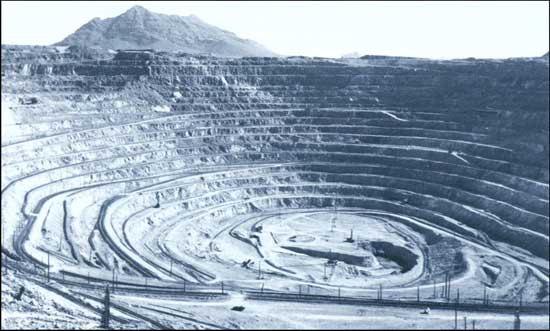
|
|
This open pit copper mine originated with mining claims on federal
land near Ajo, Arizona. (BLM)
|
|
|
The mining industry resisted any proposed changes to
the 1872 act. FLPMA made the first changes to the act, providing for
the recordation of mining claims on the public lands—allowing BLM
managers to account for claims when making land use decisions. Proof of
assessment work had to be filed with BLM annually to hold claims. FLPMA
also allowed BLM to play a more active role in managing surface lands of
claims by monitoring operations to prevent unnecessary environmental
damage, and it required reclamation of mining sites.
|
|
|
In California, BLM devised a leasing scheme for a
unique energy resource—wind. Ron Hofman, Associate State Director,
arguing that wind was a resource when it blew across public lands, was
successful in establishing a leasing program with royalties based on
production. Eleven of 13 big leases still operate in the California
Desert, bringing in about $2 million annually in revenues to the U.S.
Treasury.
|
|
Alternative
Energy
Sources |
|
The Geothermal Steam Act of 1970 authorized BLM to
issue leases for development and use of geothermal resources (primarily
for the production of electricity) on federal lands. Final regulations
and a final EIS for the leasing program were published in 1973. On
January 22, 1974, BLM held its first competitive geothermal lease sale,
offering 33 tracts in California; high bids totaling $6.3 million were
received for 18 tracts.
By 1986, more than 300 leases had been issued on
federal lands in California. An area known as the Geysers in northern
California became the most productive geothermal field in the world,
with about 40 percent of its total production coming from BLM public
lands.
|
|
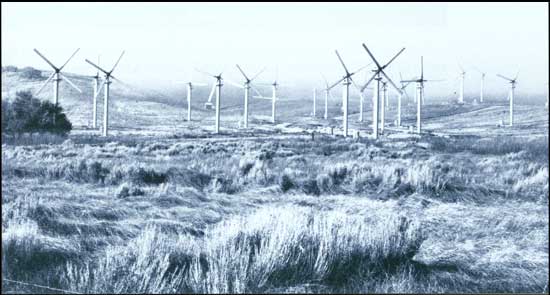
|
|
Wind energy turbines on public land at Tehachapi Pass, California
Desert District. (John Skibimski)
|
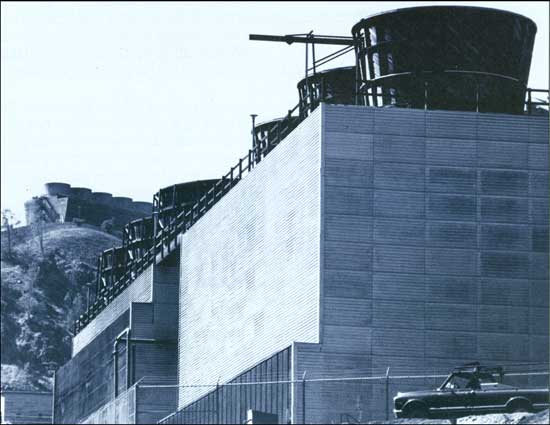
|
|
Geothermal steam is used in these Pacific Gas & Electric plants
to produce electricity in the Geysers area of BLM's Ukiah, California
District. (BLM)
|
|
|
ALASKA
|
|
|
Alaska Native claims continued to dominate debate in
Alaska in the early 1970s. Oil companies were eager to build the Alaska
Pipeline, and the state pressed to continue its land selections. But
before any of this could happen, Congress had to act on settling Native
claims.
Congress held hearings on the issue starting in 1969
but no bills emerged. In 1970, Senator Henry Jackson submitted a bill
that called for giving Alaska Natives some 10 million acres of land, $1
billion, and a share of oil revenues for a limited period of years.
Senator Ted Stevens said "I think it is a fair bill. It gives you [the
Natives] more control and self-determination than any such bill in
history." The Senate passed the bill, apparently without amendment, by a
vote of 76 to 8.
Late in 1970, the U.S. Supreme Court upheld former
Secretary Udall's "land freeze." In the House of Representatives, the
Subcommittee on Indian Affairs informally agreed to give Natives title
to 40 million acres, but no report on that matter was provided.
In the next session of Congress—1971—three
bills were introduced. One was the previous Jackson measure. Another,
supported by Senator Ted Kennedy, called for Natives to receive title to
60 million acres, an initial payment of $500 million, perpetual sharing
of minerals in lands claimed but to which title was not given, and
establishment of regional corporations. The last bill, introduced by
Wayne Aspinall in the House, gave 100,000 acres to Alaska Natives and
made additional land available for subsistence use, but only on a permit
basis.
The issue was hotly debated, but the pipeline forced
compromise. Oil companies wanted to recover their costs by moving
crude—they had paid $900 million in bonus bids to the state to lease
lands on the North Slope in 1969 alone. As law professor Monroe E. Price pointed
out, "There would have been no Native Claims Settlement Act of the
present magnitude had it not been for the intense interest of the oil
companies in its passage."
In April 1971, the Nixon administration put forth a
proposal which included 40 million acres for natives, $500 million in
compensation from the Treasury, and an additional $500 million from
mineral royalties. This bill, "the Alaska Native Claims Settlement Act,"
was presented by Nixon in a special message to Congress. After
considerable debate, a conference committee measure was accepted by the
House and Senate on December 14. Before signing the bill, however, Nixon
asked the Alaska Federation of Natives to tell him if they approved of
the act. By a vote of 511-56, they put their blessings on the bill.
On December 18, the day the Natives approved, President Nixon signed the
legislation.
The Alaska Native Claims Settlement Act of 1971
(ANCSA) gave 40 million acres of land to natives and extinguished claims
based on aboriginal rights to any other lands. ANCSA provided $962.5
million in compensation for claims not recognized ($462.5 million paid
up front, the rest to be paid over time to Native corporations) and
repealed the Native Allotment Act of 1906. ANCSA also established Native Villages to control surface
resources and Regional Corporations to control the subsurface resources.
Each Native was given 100 shares in Regional Corporations, which could
not be sold until 1991. The first conveyance of land to a Native
Corporation occurred on March 27, 1974.
|
|
|
UPHEAVAL IN ALASKA LAND STATUS
by Curtis V. McVee
Alaska State Director-Retired
When I came to Alaska in 1967, I was told by somebody
in D.C. that Alaska was not a good place for your career because the
land was all tied up. The land protest by the Native groups in 1965 and
the resulting Public Land Order (4582) in 1968 had frozen the land
status.
For a number of years not much was happening. People
in Alaska wanted to do things. Some could not acquire land for
homesteads; public projects like highways and airports were at a
standstill; and pressure was building from private corporations to lease
lands for oil exploration and development.
Recognizing the problem, Congress passed the Alaska
Native Claims Settlement Act (ANCSA) in 1971. While the intent of the
law was valid—to convey lands to the Natives as quickly as
possible—the law itself contained built-in controversy. Section
17(d)(2) of the act allowed for the withdrawal of 80 million acres for
possible additions to national park, forest, wildlife refuge, and wild
and scenic river systems. Native leaders objected to various easements
being considered for reservation, due to the cultural significance of
the lands for their people. Recreationists insisted more easements be
reserved.
Needless to say, we were ill-equipped to handle the
pending tasks. We were very poorly staffed and we were doing things
manually—at what I call "one stage past the crowquill pen."
Guidelines needed to be established to improve and speed up the
conveyance process, yet protect the rights of all concerned. Studies
were needed of Native populations and entitlements. New fact-finding
processes, once developed, would require a great amount of field
examination and time. Fortunately, the Bureau soon set up a coordination
office, and we started to get more staff and budget.

(Carolyn Roth)
|
I remember once during this period, Assistant
Secretary Harrison Loesch came here for a couple of meetings with Native
groups. We hadn't yet decided how the act should be implemented, but we
had drafted some proposed regulations. We are not prepared for the
reaction we got. At our first meeting, about 150 to 200 people attended.
When the proposal was presented, the Natives became angry because they
had not been involved. They even threatened to leave the meeting!
When the meeting adjourned, we went upstairs with the
Departmental representatives. At that point, I think they began to
finally understand some of the problems involved with the act. We set up
a task group to go to D.C. and work on the regulations as a team. That
really helped get the Department's attention. They had thought of it as
just another land law that had been developed by Congress. They soon
became aware it was not just a question of economics and politics, but had
roots back into the aboriginal cultures of these various Native groups.
Once we got that understanding, things went better.
Now, 20 years later, we're still working on some of
this in Alaska.
|
|
|
Thus, according to professor Price, "By legislative stroke, the Congress
converted all Alaska Natives into members of the corporate world,
receivers of annual reports, proxy statements, solicitations and balance
sheets." With this act, work on the pipeline could begin.
|
|
|
BLM began withdrawing a corridor across public lands for the
pipeline in 1971. An EIS was prepared and released in 1972, but was
immediately contested by environmentalists. In 1973, the federal courts ruled
that Interior could not grant the right-of-way width given by
BLM. Congress, concerned with the energy crisis, overruled the court's
ruling in November 1973 and declared the EIS sufficient—ending further debate. The
vote was close, however: Vice President Spiro Agnew had to break a tie in the
Senate.
|
|
Alaska
Pipeline |
|
Interior issued a permit to build the pipeline on January 23, 1974. Work
began in late April that year. As many as 21,600 employees worked around
the clock to build the pipeline, which consists of a 4-foot diameter
pipe that is 800 miles long (422 miles above ground, the rest below).
The pipeline was completed in 1977. Oil first entered the line on June
20, 1977, and reached Valdez on the southern Alaska coast on July 28,
1977.
|
|
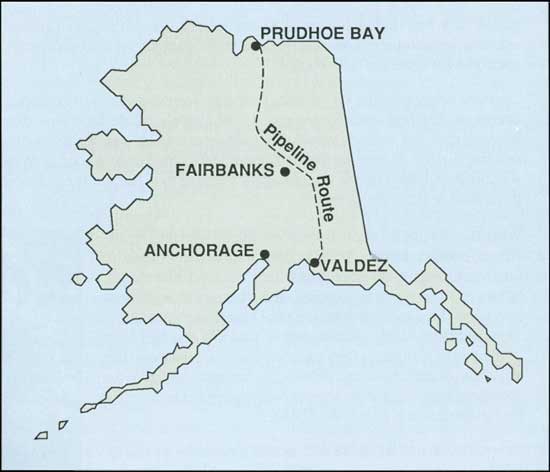
|
|
Route of the Alaska Pipeline
|
|
A WORLD CLASS PROJECT: THE TRANS-ALASKA
PIPELINE
by Arlan Kohl
Trans-Alaska Pipeline System Project Manager—Retired
Editor's Note: Arlan Kohl had a long association with
the Trans-Alaska pipeline. In 1971 he joined the Washington Office's
Alaska Pipeline staff to coordinate intra-agency and congressional
activities. In 1973 he moved to Alaska and held various technical and
professional positions related to pipeline construction and operation.
When he retired from BLM in 1987 Arlan was the Trans-Alaska Pipeline
System project manager, responsible for monitoring pipeline companies
for compliance with Interior right-of-way stipulations.
The Trans-Alaska Pipeline System is a project of
superlatives. It transports crude oil from the largest oil field in
North America to the ice-free port of Valdez on the Gulf of Alaska. It
was the first hot crude oil pipeline, pumping oil at a temperature of
145°F, built through areas containing permafrost. The first bridge
across the Yukon River and the first road to the Arctic Ocean in the
United States were constructed in support of the pipeline project. It
was and still is the most expensive privately financed project in the
world, costing $8 billion.
If not the first, the Trans-Alaska Pipeline System
was one of the first major projects constructed after passage of the
National Environmental Policy Act of 1970. The nine-volume
Environmental Impact Statement primarily dealt with problems associated
with a major oil spill and how the elevated sections of the pipeline
would affect wildlife migration routes, particularly those of caribou
herds. A challenge of the report's adequacy was filed in federal court,
but congressional passage of the Trans-Alaskan Pipeline Authorization
Act laid the issue to rest by directing the Secretary of the Interior to
issue the permits necessary for construction.
Heading the pipeline effort was the Alaska Pipeline
Office. The office monitored the construction activity of the pipeline
to ensure minimal environmental disruption and to assure the
construction quality of the pipeline. At the height of the project the
Alaska Pipeline Office had 50 permanent employees.
Because of the world class nature of the project, it
received national and international attention. The Alaska Pipeline
Office, organized to monitor construction of the pipeline, played host
to many delegations from around the world who came to observe
construction. There were representatives from Canada, Germany, Norway,
Great Britain, Japan, and the Soviet Union. As a result of the
experience gained from the project, three BLM employees made a trip to
the Soviet Union on technical exchange programs.
The pipeline project also received the attention of
prominent political personalities and celebrities. During construction,
President Gerald Ford visited Alaska and toured the project. There were
many visits by members of Congress and every Secretary of the Interior
since the project was proposed has visited the pipeline. Astronaut Wally
Schirra was given a special briefing on the project in connection with a
documentary film he was to narrate. Gladys Knight and the Pips spent a
night at Tonsina Camp when their group got caught in a snowstorm along
the pipeline route.
The Trans-Alaska Pipeline Project was an exciting
project to work on. I will forever be grateful for the opportunity to have been associated
with the project.
|
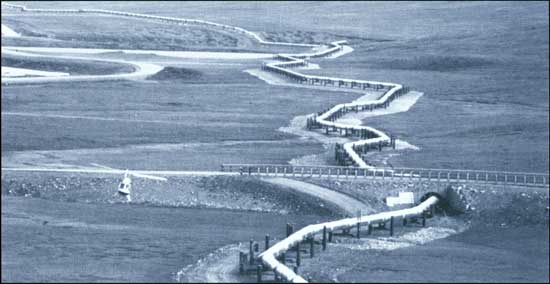
|
|
Alaska Pipeline (BLM)
|
|
|
The pipeline's cost has been placed at anywhere from
$7.7 billion to $10 billion. The pipeline chalked up firsts in several
areas—it is the first American line to be built across unstable
permafrost and the nation's first hot oil pipeline (oil comes out of the
ground at 145° F.). The US-USSR Environmental Agreement of 1972
allowed several BLM employees to learn first-hand about permafrost
construction techniques from the Russians—which allowed the
Department to develop environmental stipulations and quite probably
saved the oil companies several billion dollars. Its 10 pumping stations
deliver 2 million barrels of oil per day, which in 1982 supplied 10
percent of the nation's energy needs. At Valdez, there are 18 oil
storage tanks that hold 500,000 barrels each.
BLM's Office of Special Projects in Alaska monitored
the activities within the pipeline corridor, which crosses some 500
miles of BLM-administered lands. BLM was reimbursed for this work
by pipeline owners.
|
|
|
Environmentalists realized early that efforts to
block the pipeline would not meet with success. However, when ANCSA was being
debated, they successfully negotiated Section 17 (d)(2), which
directed the Secretary of Interior to withdraw up to 80
million acres of public land for study as new national parks, wildlife
refuges, forests, and wild and scenic river systems. The Secretary was
given 2 years to formulate the Department's recommendations; Congress
was given 5 years to act on them. When withdrawn, the "d(2)" lands were
protected from all forms of appropriation, including mining claims and
mineral leasing (most withdrawals are usually open to the latter two
actions).
|
|
d(2) Lands |
|
On March 15, 1972, Interior Secretary Morton made
preliminary set-asides, consisting of 83 million acres. Alaska quickly
sued because some 40 million acres conflicted with lands they wanted and
were entitled to under the Statehood Act. (When ANCSA passed, the state
prepared a selection list of some 77 million acres and filed it with BLM on
January 22, 1972.)
|
|
|
RALPH, RITA, AND GENA
by Tom Noble
Cadastral Surveyor, Alaska State Office
BLM in Alaska has been a proving ground for new
technology, mostly out of necessity. The state is just too large and
diverse for land management and survey problems to be handled with
traditional methods.
In the early 1970s, a new technology was being
developed by Litton Industries. An Inertial Guidance System was being
tested for aircraft navigation, and I think to the surprise of everyone,
including Litton, was showing much higher accuracy than anticipated. BLM
and Litton agreed to test and refine the inertial system to see if
survey accuracy could be achieved. It could; the system was ideally
suited for the type of surveying to be done in Alaska at that
time—the skeletonized township boundaries of the tremendously large
tracts of land needing to be transferred to state and Native ownership.
During that first year, the advantages of the system over traditional
methods were immediately apparent, and the techniques and procedures
have been continually tested, developed, and refined.
My first experience with the Auto-SurveyorTM was in
1976, as a co-op student with the Oregon Institute of Technology on a
summer adventure to Alaska. That first Auto-SurveyorTM cost over
$750,000, including spare parts, training, and some computer software.
It was nicknamed "Ralph," which was much easier to say than Litton
Auto-SurveyorTM System. That summer Ralph helped us establish over
1,000 protracted survey monuments in approximately 150 townships. Ralph
was doing so well, in fact, providing accurate geographic coordinates
quickly and efficiently, that by 1977, BLM decided to purchase another
Auto-SurveyorTM. "Rita" was purchased, at a cost of about
$500,000. Combined, Ralph and Rita surveyed hundreds of thousands of
acres and positioned thousands of survey monuments. On several
occasions during the winter, when surveying in the field in Alaska is
impractical, they were used in "Lower 48" resurveys. With still a
tremendous amount of land yet to be surveyed, "Gena" was purchased in
1981 for about the same price as "Rita."
The immense number of lakes and other water bodies in
Alaska led to the development of an additional
Auto-SurveyorTM capability, known as meander mode. This
capability was developed because of the growing problems concerning the
segregation of the bodies of water from the land areas to be patented.
Meander mode enables Ralph to collect data, latitude and longitude, from
a moving vehicle. A helicopter is flown along the shoreline of a lake or
river, and at the punch of a button, Ralph records the data. This data
is later read by other computers, and then used to create survey plats
and field notes.
The Auto-SurveyorTM is truly remarkable
and it amazes me that it is nearly 15 years old. There is still a lot of
life left in Ralph, Rita, and Gena, and there is still not a survey
instrument that can do as much, as easily, as the
Auto-SurveyorTM. There have been quite a few technological
advancements in the last 10 to 15 years however, and the era of Ralph,
sad to say, is probably nearing its end.
|
|
|
Interior and Alaska negotiated until September 1972,
when a deal was reached that gave the State of Alaska prior right to
some 1.9 million acres of d(2) lands. The state then withdrew selection
of some 36 million acres of land, while another 41 million acres were
validated.
|
|
|
Morton came up with a concrete proposal in
December 1973 for the d(2) lands. He proposed 83 million acres under the
"four systems," noting that the area within the national park system
would be doubled by his plan. Morton's plan doubled the size of Mt.
McKinley National Park and added three new parks in Alaska. It also
added three national forests and numerous wildlife refuges, plus wild
and scenic river areas.
|
|
Secretary
Morton's
Proposal |
|
By law, Congress had to respond to Morton's proposal
by December 1978. President Ford backed the "park expansion plan" for
Alaska but his effort came too late in his administration to accomplish
it. President Carter and Secretary Andrus gave the proposal top priority
on their agenda. In September 1977, they came up with a plan more
ambitious than Morton's, calling for 91.8 million acres to be included
as "National Interest" lands—41.7 million acres for 10 new parks,
45.1 million acres for wildlife refuges, and 2.5 million acres for wild
and scenic rivers. New National Forests were eliminated from the
proposal, but 2.5 million acres were added to existing forests.
Congress failed to act on Morton's proposals within
ANCSA's deadline. With the lands scheduled to revert back to multiple
use status, President Carter created 17 new monuments encompassing
about 56 million acres on December 1, 1978. Defending the Executive
Order, Secretary Cecil Andrus said "through the enactment of our
proposals, we can be certain that the crown jewels of Alaska—its
most spectacular natural environments, recreation areas, and wildlife
habitats—will remain intact for the benefit of our nation's
citizens." President Carter felt no other action would have more
"lasting value."
|
|
|
Conservationists and land users debated this issue
for the rest of the decade. When Carter lost his bid for reelection in
1980, conservationists compromised. The Alaska National Interest Lands
Conservation Act (ANILCA) passed on December 2, 1980. The act extended
the time for Alaska to select state lands from 25 years to 35 years;
lands previously selected by the state and tentatively approved by the
Department were confirmed.
|
|
Alaska
National
Interest Lands
Conservation Act |
|
For the nation as a whole, ANILCA revoked the 1978
executive withdrawals and set aside 104.1 million acres for national
parks, wildlife refuges, recreation areas, and national conservation
areas. The act also set aside the 1 million-acre White Mountain National
Recreation Area (including two recreation trails and the Beaver Creek
Wild River) and the 1.2 million-acre Steese National Conservation Area,
which includes caribou habitat, the Birch Creek Wild River, and 125
miles of recreational trails.
|
|
|
SPECIAL MANAGEMENT AREAS ON THE PUBLIC LANDS
|
|
|
From modest beginnings in the 1960s, BLM identified
and designated millions of acres of the public lands in the lower 48
states as special management areas to recognize unique or threatened
resources on the public lands. In 1965, Secretary Udall and Director
Stoddard proposed that BLM designate 130 natural areas on BLM lands,
totaling about 500,000 acres. These lands, categorized as ecological or
geological areas, were set aside for research and educational use
through BLM's classification process. Under Boyd Rasmussen, BLM began to
designate recreation lands and other areas, such as National Natural
Landmarks.
Special management areas were designated in two ways:
by congressional or administrative action. Congress established national
trails, wild and scenic rivers, and national conservation areas. BLM and
the Department designated recreation areas, primitive areas, and natural
areas (including outstanding natural areas and research natural areas),
resource conservation areas, and other areas, such as the Little Book
Cliffs Wild Horse Range. After FLPMA passed, BLM also designated areas
of critical environmental concern (ACECs).
Under Director Burt Silcock, BLM began to set aside
major acreages of public lands. About 27,000 acres of land in the Organ
Mountains in southern New Mexico were dedicated in 1971 as a recreation
area. New Mexico State University had previously been granted the use of
2,000 acres in the area for educational purposes. In Montana, Humbug
Spires, Bear Trap Canyon, and the Centennial Mountains were designated
as primitive areas. Bear Trap Canyon was subsequently designated as
BLM's first wilderness area in 1983 as part of the Lee Metcalf
wilderness.
|
|
|
For many years, BLM's Boise District recognized that
the canyon country along the Snake River provided a unique and valuable
nesting area for birds of prey. District Manager Ed Booker "charted a
course through the Bureau's planning process to preserve the area,"
according to Silcock. In 1971, Secretary Rogers C.B. Morton withdrew
26,000 acres of land along the river for management as a natural area.
The area was renamed the Snake River Birds of Prey Area by Secretary
Cecil Andrus, who enlarged the total area to 482,640 acres in 1980.
|
|
Snake River
Birds of Prey
Natural Area |
|
The King Range National Conservation Area, containing
54,000 acres of public lands along California's northern coast, was
established by Congress in 1970 as the nation's first conservation area.
Congress required BLM to develop a management plan for the area before
it was officially designated. BLM completed an EIS and adopted
regulations for the area in 1974, when it was officially set aside.
|
|
King Range
National
Conservation
Area |
|
The King Range Act of 1970 contained provisions for
land acquisition and cash payments to equalize values of lands exchanged
with private owners and the State of California. It established a
program of multiple use and sustained yield management for the
area—provisions that would be seen again in FLPMA. Because private
and state lands were intermixed with public lands, BLM set up seven
management zones in the area to designate primary uses (three were for
recreational uses, two for residential purposes, one for forest
management, and one for wildlife habitat).
|
|
|
PHOENIX TRAINING CENTER
by Vi ille and Ken McGinty
Phoenix Training Center
As the Bureau of Land Management's technical training
facility, the Phoenix Training Center had its origin in 1969 as the
Lands and Minerals (L&M) Training School, under the administration
of the Phoenix District. The first Manager was Tom Owen. The I & M
School offered two 6-week courses each year for beginning lands and
minerals specialists. Training in lands and minerals was especially
needed because no training existed for realty specialists, and training
in the private sector did not prepare minerals specialists for Bureau
work. The school was located in the Phoenix District because it had
abundant lands cases to be worked and Arizona's mild year-round climate
would allow trainees to conduct field work during the spring and fall
semesters.
By 1972 the I & M School had a new Manager, Paul
Rigtrup. During his tenure, several lands and minerals short courses
were added to the curriculum; an administrative law course was offered
along with the Bureau's first training for area managers. In addition,
the Pipelines and Electric Systems short courses were developed and
conducted every 2 years in cooperation with the industries' respective
institutes. By October 1979, the I & M School was separated from the
Phoenix District, placed under the leadership of the BLM Arizona State
Director, and became the Phoenix Training Center. At that time, the
Training Center had a permanent staff of 10 and a 14-course curriculum
and had already conducted 2 semesters of the new long-term beginning
professional course in range management. In 1981, long-term training in
wildlife habitat management was added to the curriculum, and in 1983
training for planners was introduced. Several other forces shaped the
Training Center's evolution. The merger of BLM and the Minerals
Management Service produced a need for specialized minerals training.
The minerals curriculum increased from 4 courses in 1982 to 22 classroom
courses and 4 self-study courses in 1988. Other major changes resulted
from an evaluation of the Training Center and a decision to reorganize
it.
With the trend of budget reductions and less travel,
the Phoenix Training Center re-examined formal classroom training and
began to seek alternative training methods. In 1984, Dr. Larry Hamilton
became the Manager, responsible for implementing the Training Center's
reorganization. A division was created to design and deliver training
materials, including decentralized training packages and video
programs. Education, computer, audiovisual, and visual information
specialists were added to the staff. New program areas and
responsibilities were added: career development; soil, water, and air;
and hazardous materials management.
Two of the Training Center's attributes make it
especially effective in serving the Bureau. First is the use of visiting
instructors instead of a permanent teaching staff. Such instructors
combine subject matter expertise with field experience to best meet the
training needs of field employees. Second is that the Training Center
was designed to meet the needs of line management and is responsible to
the Arizona State Director as the representative of the Bureau
Management Team. The Training Center model, proven effective over the
years, will carry the Training Center into ensuring the best
multiple management training for Bureau employees.
|
|
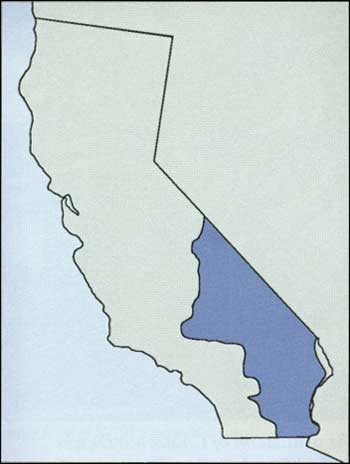
|
|
California Desert National Conservation Area
|
|
|
|
The Classification and Multiple Use Act of 1964
called for an inventory of BLM lands in the California Desert to
determine what areas should be retained in federal ownership. BLM's
challenge on the California Desert was to identify land uses and types
of management required in an area receiving increasing use by the
public. Almost all of BLM's 12.5 million acres (half of the desert's
total area) were classified for retention and multiple use
management.
|
|
California
Desert |
|
In 1971, Secretary Morton dedicated 19 areas
comprising 2.7 million acres in the California Desert as "National
Recreation Lands." BLM identified these areas through the CMU Act,
its own planning system, and extensive public
involvement. BLM estimated that public lands in the California Desert
supported more than 7 million visitor-use days annually; after the
recreation areas were formally designated, this figure doubled.
The California Desert Conservation Area was
established by FLPMA in 1976, with a draft management plan and final EIS
issued for comment and review by the public in September 1980. Twelve
public meetings were held in the area, and BLM received more than 40,000
written comments from across the country (with its analysis audited by
the California League of Women Voters to assure impartiality and
fairness to all users). The plan allocated desert land into geographic
areas according to their primary uses. Class "C" (Controlled Use) areas
totalled 2.1 million acres, or 17.3 percent of the total area. Most of
these lands (45 sites totaling 2 million acres) were designated areas of
critical environmental concern and proposed for inclusion to the national
wilderness system. Class "L" lands (Limited Use) totaled 5.9 million
acres (48.5 percent of the total); only low-intensity multiple land uses
would be allowed, in order to protect resource values.
Class "M" lands (Moderate Use) struck a balance
between use and preservation, allowing a variety of uses on 3.3 million
acres. Class "I" (Intensive Use) lands allowed concentrated uses on
500,000 acres of lands by interests as diverse as off-road vehicle (ORV)
enthusiasts or hardrock miners. The plan designated most of this acreage as
ORV areas, including dry lake beds and sand dune systems.
|
|
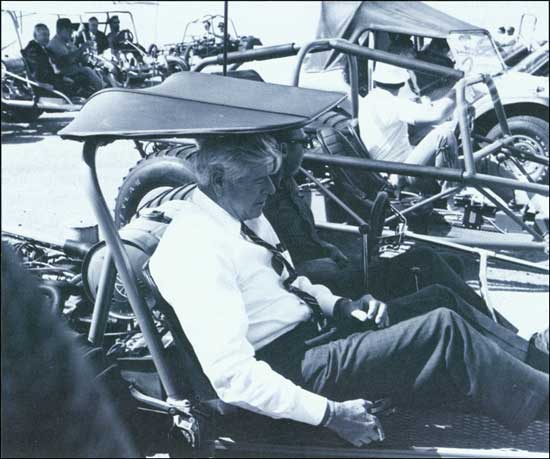
|
|
Secretary Rogers C. B. Morton rode to the dedication of California
Desert National Recreation Lands with dune buggy driver Jerry Van
Warmer. (BLM)
|
|
|
The final plan was approved in December 1980. Public
involvement helped BLM resolve a number of thorny issues; with the
public's approval, BLM expedited the removal of 10,000 burros from
critical desert bighorn sheep habitats and desert tortoise areas. In
addition, BLM exchanged 5,600 acres of lands west of Blythe, California,
for 480 acres of redwood forests owned by the San Diego Gas and Electric
Company in the northern part of the state, plus 1,580 acres of land for
addition to the Desert Tortoise Natural Area.
|
|
|
LAW ENFORCEMENT
|
|
|
As early as 1968, California State Director J. Russell Penny
proposed that a ranger force be established on the California
Desert to supervise and control the desert's fast-growing recreational uses.
About 95 percent of the desert is within 3 miles of a road, and more than 12 million potential
visitors live within 100 miles of the desert.
|
|
Desert
Rangers |
|
BLM hired its first desert ranger in the Riverside District in June
1972. During the next year, Riverside District Manager Del Vail hired six
additional rangers, and in 1974, 21 more. Because rangers didn't have
law enforcement authorities, their duties were originally
to oversee off-road vehicle use and report any violations of the law to
state or local law enforcement officials. Rangers also gathered data on
wildlife populations and habitats, archaeological sites, and other
resources, and provided interpretive information to the public.
|
|
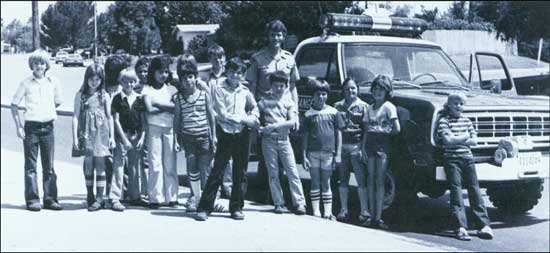
|
|
Providing information and helping visitors understand the desert's
fragile resources takes up much of a BLM ranger's time. (BLM)
|
|
|
In November 1973, President Nixon issued an Executive
Order calling on BLM to develop an "Interim Critical Management Program"
for recreational vehicle use on BLM desert lands, which BLM completed in
1974. However, desert rangers were not granted their own enforcement
authority until FLPMA was passed in 1976. By this time, their numbers
had doubled and they were being hired outside California. But after
receiving law enforcement authority, Steve Smith of the California State
Office said that "in most cases, the rangers were able to substitute
persuasion and diplomacy to avoid using their powers of arrest."
|
|
|
BLM's first authority for law enforcement was
provided by the Wild and Free Roaming Horse and Burro Act in 1971; the
Bureau hired its first special agent under the act in 1974. FLPMA gave
BLM its first general authority covering all public lands. The Bureau
signed contracts and entered into cooperative agreements with state and
local agencies to enforce state and local ordinances. Special agents
(also known as criminal investigators) probed violations of the Wild
Horse and Burro Act, the Archaeological Resources Protection Act, and
the Public Rangelands Improvement Act.
|
|
Law
Enforcement
Authority |
|
BLM estimated that 85 percent of its law enforcement
work consisted of crimes against property or wild horses and burros. In
1979, the Federal Magistrate Act gave desert rangers authority to issue
violation notices for misdemeanors.
|
|
|
A DIRECTOR'S PERSPECTIVE: 1978-1981
by Frank Gregg
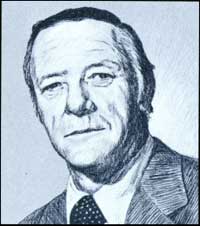
Frank Gregg (Jennifer Reese)
|
Editor's Note: Frank Gregg, a native of Colorado, began a
long career in natural resources in 1951 with the State's Game and Fish
Department. He served as executive director of the Izaak Walton League,
staff assistant to Secretary Udall, and vice president of the Conservation
Foundation, and was chairman of the New England River Basins Commission before
becoming Director of BLM in February 1978. He is now a professor at the
University of Arizona. This sidebar and his article on FLPMA were excerpted
from a longer paper, Implementing FLPMA: Fashioning Management Systems
in an Era of Political Volatility, in press.
I have followed BLM since the 1950s, first stimulated
by livestock-wildlife conflicts and proposals for federal land disposal,
and continued as a Secretarial staff assistant and conservation lobbyist
in Washington through Chuck Stoddard's and Boyd Rasmussen's tenure. I
was determined to help the Bureau build on FLPMA to establish a stable,
professional public land management program genuinely responsive to the
diverse range of demands on public land resources. I saw the land use
planning process mandated by FLPMA as a way of assuring that all points
of view were brought to bear on land use decisions in the field, and to
enhance the capacity of the Washington Office to influence policy
decisions of the Department, OMB, and the Congress affecting public
lands.
The delay in my installation as Director was
particularly frustrating because Secretary Andrus and Assistant
Secretary Martin moved quickly with policy and program changes. The
Bureau's career leaders had looked forward to having a strong hand in
early implementation of FLPMA; instead it often found itself responding
to individual initiatives from Secretarial offices, formulated outside
the multiple-use context the Bureau preferred. As a signal to public
land user groups, I held a series of well-publicized meetings in several
western states in which local, regional, and national issues were
discussed with audiences representing the full range of interest groups.
The objective was simple: to let all hands know they could expect
even-handed responses on wilderness, grazing administration, coal
leasing, and other controversies. The strategy worked: even at the
height of Sagebrush Rebellion oratory, communications with public land
users and their political allies were easy and open.
At headquarters, BLM was reorganized and partially
restaffed to provide a focal point for both renewable and nonrenewable
resources, and to sharpen policy analysis and advocacy skills essential
in a Washington office. Winning a few early battles (notably delegating
approval of land use plans and related EISs to State Directors) helped
restore the Bureau's role in Departmental policy councils. State
Directors were made key players in Bureau policy deliberations through
carefully planned and staffed meetings on program policy issues.
Progress in major programs was substantial. A new
coal leasing program and EIS were formulated; leasing was resumed in
1980 without legal challenge. A "principled" (my word) approach to the
westwide wilderness review specified in FLPMA was scrupulously
objective in initial stages, to avoid demand for repeated reviews.
Wildlife programs were sharply strengthened, a priority dating back
to my early years in Colorado.
A coalition of user groups helped enact the Public
Rangelands Improvement Act of 1978 around a common interest in
increased funding for improving rangeland condition, and came close
to agreement on processes for making decisions about livestock grazing
use in response to court-ordered grazing EISs. A Special Projects Office
helped meet urgent schedules for siting energy facilities. OCS leasing
was expanded in new frontier areas with careful concern for
environmental and social impacts. The California Desert Plan was
completed with the help of a strong citizens' advisory committee, and
withstood early challenges from a new administration. A network of
regulations for implementing FLPMA emerged. The first-ever regulations
on surface effects of hardrock mining took effect.
BLM's progress toward establishing itself as a strong,
stable institution of career natural resource professionals was mixed.
While the policy and budget priorities of the Carter Administration were
supportive and congressional leadership was exemplary, images and perceptions
of the Bureau were as often diminished as enhanced by the administration
and diminished further by the vehemence of attacks in the 1980 campaign
and immediately thereafter by supporters and officials of the new
administration.
President Carter's zeal to reorganize, including a proposal
to convert Interior into a Department of Natural Resources incorporating the
Forest Service, was the root of serious damage to BLM. White House reorganization
strategists sought to win FS support by downgrading BLM's competence and
integrity, and promising to consolidate the two land systems under FS leadership.
Even the Secretary occasionally joined in this forlorn tactic.
BLM and other federal agencies were also pawns in a federal-state water
controversy. Field offices were accused (inaccurately) by some western water
leaders of planning to claim vast quantities in the process of filing under state law
for water rights for land management. Casual examination would have shown the amounts claimed to be
modest indeed. But the administration's public response took the form of promising to
protect western water interests from the agencies, instead of pointing to the record.
The Carter/Andrus record shows increasing support for BLM as time
went on. When it became obvious that the reorganization would fail, Andrus helped secure
support for a strengthened BLM in budget and manpower allocations. Andrus came, in
his last months, to assert a commitment to BLM as the "Best Land Manager" among
federal agencies. In controversial program areas, such as coal leasing, wilderness review,
and livestock grazing, his support was unwavering. In his last appearance before
Department employees, Andrus was moved to tears when he came to comment on his
administration's work with BLM. But the opportunity to fully capitalize on his support was lost
in the change of administration in 1981.
BLM entered the second post-FLPMA administration with
modest increases in staff and appropriations, stronger support among western governors, the
environmental community and key leaders in the House, a solid start toward consolidation of basic
management systems, remarkable progress in specific program areas—and the dubious
distinction of serving again as a symbol of need for dramatic policy change by a new
administration.
|
|
|
RENEWABLE RESOURCE PROGRAMS: SOIL, AIR AND WATER
|
|
|
BLM's watershed program grew to include additional
areas of responsibility, including air resource management, in the
1970s. Several acts affected the program, but their effects on land
management activities were not immediately apparent until litigation and
court decisions forced the Environmental Protection Agency (EPA) to
expand the acts' authorities to all areas of the United States.
|
|
|
The Clean Air Act of 1970 required EPA to establish
national primary and secondary air quality standards, including
standards for new pollution and hazardous substance sources. While the
initial focus of this act centered on automobiles and point-source
pollution, many states adopted regulations controlling open burning on
federal public lands.
|
|
Clean Air Act
of 1970 |
|
Prevention of Significant Deterioration (PSD)
regulations were developed under the act following litigation from the
Sierra Club in 1975. Under these regulations, EPA established three
classes of clean air regions for the nation:
Class I — pristine areas where no deterioration was
allowed;
Class II — areas permitted to undergo moderate
changes; and
Class III — areas where development was allowed, up
to the secondary national standards given in the act.
|
|
PSD
Regulations |
|
The Secretary of the Interior was given the
responsibility to designate areas for management as Class I areas.
Amendments to the act in 1977 reaffirmed the PSD concept and
strengthened its provisions. All national parks, monuments, and
wilderness areas were designated Class I areas, with other public land
areas designated Class II; states or the Department, however, could
reclassify any Class II areas as Class I areas.
|
|
|
The Federal Water Pollution Control Act (FWPCA)
focused on industrial pollution in urban areas and on oil spills.
Section 208 of the act, however, covered nonpoint pollution sources and
required states to develop areawide waste management plans. The act also
created the Colorado River Basin Salinity Control Forum, representing
seven basin states, to develop numeric criteria for salinity allowed in
the Colorado River—much of which originated on public lands. In
1974, the Colorado River Basin Salinity Control Act authorized
construction of four salinity control units in the basin and required
planning reports be completed in 12 other units.
|
|
Federal Water
Pollution
Control Act |
|
Under FWPCA, EPA proposed that forestry and
agricultural activities be designated as point sources, but withdrew the
idea in 1972. NRDC successfully sued EPA on this issue in 1975, forcing
EPA to develop new regulations. Published in 1976, the regulations
addressed water pollution from forest and range management
activities.
|
|
|
The Clean Water Act of 1977 amended Section 208 of
FWPCA to mandate statewide planning and authorized cost-sharing programs
with rural landowners to control nonpoint sources through
their Soil Conservation Districts. The act also exempted road building
activities in forests from its provisions only if "best management
practices" developed by BLM and the Forest Service were followed.
|
|
Clean Water
Act |
|
The Resource Conservation and Recovery Act of 1976
provided funds to state and local governments to "provide the
demonstration, construction, and application of solid waste management
and resource recovery systems which preserve and enhance the quality of
air, water and land resources." One of the act's provisions called for
establishing a national system of disposal sites for hazardous wastes,
some of which occurred on BLM lands (e.g., the Waste Isolation Pilot
Project in southeast New Mexico, which stores government-produced
radioactive wastes).
|
|
Resource
Conservation
and Recovery
Act of 1976 |
|
WILDLIFE
|
|
|
BLM's wildlife program continued to grow in the
1970s, reflecting the rise in public concern for endangered species and
habitat issues for all species. The number of wildlife biologists in the
Bureau grew to 360 by 1980, with a program budget of $16 million. In
addition to NEPA and FLPMA, three acts affected the Bureau's wildlife
program.
|
|
|
The Sikes Act of 1974 promoted federal/state
cooperation in managing wildlife habitats on both BLM and Forest Service
lands. It required BLM to work with state wildlife agencies to plan the
development and maintenance of wildlife habitats, the act's primary tool
being the Habitat Management Plan (HMP).
|
|
Sikes Act of
1974 |
|
BLM completed its first HMP in 1976 in the Arizona
Strip District. By 1980, BLM signed cooperative agreements with 15 state
governments and developed 180 HMPs covering 26 million acres of public
lands and 1,000 miles of streams crossing BLM lands. Priority was given
to species requiring special attention, such as the desert bighorn sheep
(whose numbers have not recovered in its original range, unlike those of
elk, deer, and antelope) and endangered species.
|
|
|
The Endangered Species Act of 1973 provided for the
federal listing of wildlife threatened with extinction and for the
designation of critical habitat by the U.S. Fish and Wildlife Service
(FWS). The act required BLM to protect endangered species and their
habitats, and to consult with FWS on activities planned for critical
habitats. In addition, the act provided for closer working relationships
between the agencies in developing recovery plans for threatened or
endangered species.
|
|
Endangered
Species Act of
1973 |
|
The Bald Eagle Protection Act of 1972 prohibited the
poisoning of bald or golden eagles, whether intentional or
unintentional—causing significant changes in the FWS Animal Damage
Control program (now in the Department of Agriculture) and in the
activities of livestock operators on public lands. In January 1977, the
FWS published guidelines forbidding activities resulting in disturbance
to the birds.
|
|
|
WILD HORSES AND BURROS
|
|
|
The Wild Free Roaming Horse and Burro Act of 1971
gave legal status to horses and burros on the public lands and required
BLM to institute programs to protect and manage them. This act was one
of the first pieces of legislation dealing with particular species and
their habitats, specifying techniques that could—and
couldn't—be used their management. The act brought wild horses and
burros into BLM's multiple use planning process:
the Bureau began to allot forage to horses and burros
in addition to livestock and wildlife. If too many horses or burros
occurred in an area, plans were written to address how and when they
would be removed. Environmental assessments were prepared for public
review and comment—a far cry from the discretion allowed managers
in the 1950s and early 1960s.
|
|
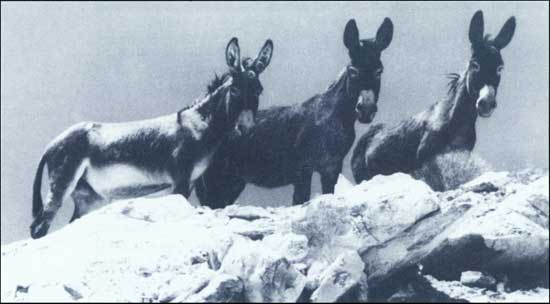
|
|
Burros in California desert (BLM)
|
|
|
The act prohibited all sales or commercial trade in
the animals and made BLM responsible for its enforcement. The Bureau
hired its first special agents under the act in 1974. Horses and burro
numbers could be controlled, however, by moving excess animals to other
areas (where they existed prior to the act), by humane destruction, or
by "adoption" to private citizens. The first option was untenable
because horse and burro numbers were increasing throughout their range.
The second, BLM correctly surmised, would never be approved on a large
scale by the public.
BLM's only viable alternative was adoption; its first
wild horse adoption took place in Montana in 1973. Because early efforts
proved successful and were received with widespread public support, the
Bureau implemented a nationwide Adopt-A-Horse program in 1976. By 1980,
the public had adopted more than 20,000 horses and 2,000 burros through
the program.
|
|

|
|
Wild horses in Sand Springs roundup, Vale, Oregon (BLM)
|
|
|
The protection afforded horses and burros under the
act allowed for rapid increases in their population throughout the West.
By 1980, BLM estimated that wild horse numbers exceeded 52,000, and
burros 12,000, on the public lands, with some herds growing by 15 to 20
percent each year.
BLM found itself facing a whole new array of
problems. In January 1976, animal unit months for livestock grazing were
reduced in the Burns District (Oregon) in response to reductions in
forage caused by wild horses in the area. A cattleman affected by this
reduction filed a claim for damages with the Interior Department but was
not successful. New Mexico challenged the act's constitutionality,
claiming it violated the state's right to manage wildlife within its
borders. Initially found unconstitutional, the act was later upheld by
the Supreme Court, which decided the federal government had authority to
manage horses—and other wildlife species—on the public lands.
|
|
|
CULTURAL RESOURCES
|
|
|
Until 1971, most land-managing agencies thought that the National
Historic Preservation Act of 1966 (NHPA) applied only to nonfederal
cultural resources affected by federally aided construction such a
highways, dams, and urban renewal projects. By
issuing Executive Order 11593, President Nixon informed federal
land-managing agencies that they too were obliged to protect cultural
resources. Executive Order 11593 required agencies to inventory and
evaluate all significant cultural resources under their jurisdiction
within 2 years—an impossible task for an agency managing 500
million acres of land—and to protect them from inadvertent harm.
Expanding its ability to assist State Offices, the BLM Service Center
added a historian and a second archaeologist to its staff.
|
|
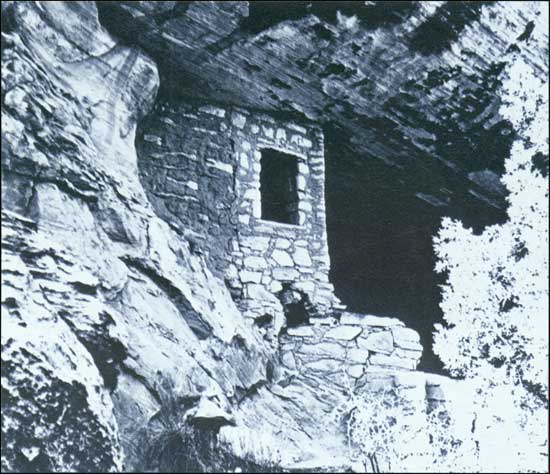
|
|
Archaeological site, Granary with two types periods of construction
in Moab District, Utah. (William T. Rolen, Jr.)
|
|
|
Detailed NHPA regulations were published by the
Advisory Council on Historic Preservation in 1974. In response, BLM
State Offices and a few Districts were staffed with cultural resource
specialists by the end of fiscal year 1974; most other Districts were
staffed in 1975, and most Resource Areas by 1977. Alden Sievers of the
Washington Office's recreation staff began laying the foundations for a
cultural resources program in 1974. Rick Hanks, archaeologist for the
California Desert planning staff, served as program leader from 1976 to
1980, establishing the planning-based structure that continues to shape
the program.
Cultural specialists in the field were primarily
responsible for inventories needed for land use plans or for proposed
projects such as right-of-way applications, range improvements, mineral
development, and other actions. Because locations were chosen for
resource or engineering reasons, these new specialists visited places where
archaeologists had never thought about going, "finding an unanticipated
wealth of archaeological and historic resources of kinds never before
described or interpreted," according to John Douglas, current program
leader in the Washington Office.
|
|
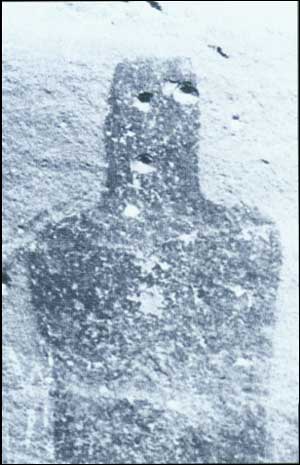
|
|
Pictograph used as a target by irresponsible public, Moab, Utah.
(William T. Rolen, Jr.)
|
It soon became evident that BLM lands held an abundance of cultural
resources, estimated in 1977 at 500,000 properties. Rapidly accumulating
survey data bumped that estimate upward—to as many as 3 to
million—according to Douglas, who stated that "acre for acre, no
other agency approaches the number, variety, and importance of BLM's
cultural resources."
FLPMA reemphasized Executive Order 11593's message,
naming cultural resources among the Bureau's multiple use
responsibilities and focusing on the role of inventory in planning and
management. The 1970s closed with the passage of another important
statute, the Archaeological Resources Protection Act of 1979 (ARPA). Its
predecessor, the Antiquities Act of 1906, had been disabled as a
criminal statute in most of the West by a 1974 ruling in the Ninth
Circuit Court of Appeals. ARPA resolved the Court issue, boosting the
Antiquities Act's misdemeanor offenses to felonies; it also prohibited
trafficking and possession in addition to unauthorized excavation and
removal, to address dealers and collectors as well as diggers.
By the end of the decade, BLM had the authority and
much of the capability needed to protect its huge reserve of cultural
resources from conflicts generated by legitimate land use activities on
the one hand, and from illegal depredation on the other. Both of those
concerns, however, were almost purely reactive. What was lacking,
according to Douglas, was the ability to get out ahead of Section 106
compliance—and artifact hunters—to determine, for the
resources' own sake, how they should be managed over the long term. This
became the program's main task in the 1980s.
|
|
|
RECREATION
|
|
|
Recreation on the public lands rose steadily during the 1970s,
approaching 50 million visitor-use days each year. By 1972, the Bureau
hired an additional 30 outdoor recreation planners on the ground so that
virtually all District Offices were staffed with these positions.
By the mid-1970s, BLM was maintaining more than 400 developed
recreation sites on the public lands, with an annual budget averaging
$5 million for recreation management, $3 million for site maintenance,
and $1 million for recreation construction. For America's Bicentennial in
1976, BLM built interpretive facilities along the Oregon, Pony Express,
and Dominquez-Escalante Trails. In 1978, the Land and Water Conservation
Fund Act was amended by Congress to authorize an increase in its
base funds to $900 million annually.
|
|
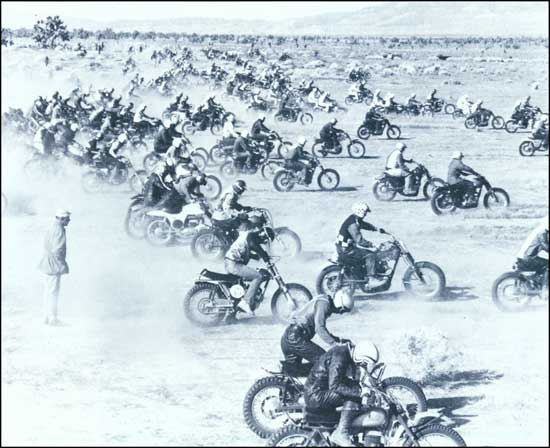
|
|
The start of a hare and hound race over approximately a 150 mile
course, Little Rock Area, California. (BLM)
|
|
|
WILDERNESS
|
|
|
Section 603 of FLPMA set up BLM's wilderness review
process. Within 15 years the Secretary was to review roadless areas or
"islands" of 5,000 acres or more on the public lands identified during a
prescribed inventory process (Section 201) as having wilderness
characteristics described in the Wilderness Act of 1964 and to "report
to the President his recommendation as to the suitability or
nonsuitability of each such area or island for preservation as
wilderness."
BLM established a review process consisting of three
phases: inventory, study, and reporting to Congress. During
the inventory phase, BLM identified wilderness study areas (WSAs) after
asking for public participation and review of its work. The inventory,
completed in November 1980 in the lower 48 states, identified more
than 24 million acres of public lands as WSAs and eliminated
approximately 150 million acres from further consideration.
Outdoor recreation planners were given the primary
task of inventorying and identifying wilderness study areas on the
public lands. Each WSA was then studied—or is now being
studied—by all Bureau programs and the public, through BLM's
planning system, to consider all values, resources, and uses within the
area. The findings of these studies have determined or will determine
whether the areas should be recommended for designation as wilderness.
Reports on all WSAs must reach the President no later than October 1991
and Congress by October 1993. Mineral surveys will be conducted by the
U.S. Geological Survey and Bureau of Mines for areas recommended as
suitable.
|
|
|
RANGE
|
|
|
The Federal Advisory Committee Act of 1972 directed
the Executive Branch to make more effective use of its boards, setting
up criteria for the creation, supervision, and operation of advisory
boards. Section 14 of the act required that BLM's boards be specifically
renewed by the Secretary of the Interior.
In response to this act, BLM realigned membership on
the National Advisory Board Council; livestock members were reduced from
20 to 10 and wildlife interests from 10 to 6. Representatives of other
groups increased—three for outdoor recreation, and one each for
forestry, environmental quality, mining, county and state governments,
leasable minerals, and public utilities.
BLM retained its tri-level advisory board system
(national, state and district). State and O&C multiple use advisory
boards were continued, while District grazing advisory boards were
supplemented with multiple use advisory boards at the field level.
Grazing advisory boards were extended by FLPMA for 10 years to advise
Districts on AMPs and range improvement funds.
Anyone who doubts the significance of NEPA's impacts
on BLM should examine the Bureau's range program in the 1970s. Range
conditions on public land were attracting criticism from environmental
groups and national attention from the news media. Readers Digest
published an article on overgrazing, "Nibbling Away at the West," in
1971 and National Geographic carried a story on the plight of
bighorn sheep in Challis, Idaho in 1973.
BLM was well aware of its requirements under NEPA to
examine the impacts of significant actions on the environment, including
those of its range program. By 1972, the Bureau decided to examine
national impacts and policies in a programmatic statement. Probably
another reason for choosing this approach was that BLM simply didn't
have enough range employees or forage inventory data collected to
prepare site-specific EISs.
|
|
|
IMPLEMENTING FLPMA
by Frank Gregg
With the passage of FLPMA in 1976, BLM had reason to
hope for a period of stability, a window of opportunity to
concentrate on refinement of multiple use management systems for the
public lands. It didn't work out that way. On the contrary, the years
immediately after FLPMA were arguably among the most politically
volatile in public land history.
FLPMA itself precipitated controversy. The Act gave
environmental and recreation interests a position of legal equality with
the historically dominant commodity uses of mining, grazing, oil and
gas, timber. Decisions about the use of specific public land areas were
to be based on land use plans and environmental impact statements
prepared with public participation. All roadless areas were to be
reviewed for potential designation and protection as wilderness.
Concerns of resource development interests were heightened by the candid
commitment of the Carter Administration to environmental goals, and by
the public environmental records of Secretary of the Interior Cecil
Andrus, Assistant Secretary Guy Martin, and me.
Beyond these changes, commodity programs Bureauwide
were being examined under the glare of EISs in response to NEPA lawsuits
brought by environmental organizations. Livestock grazers were faced
with examination of grazing effects on public lands through a series of
144 site-specific EISs, Coal leasing had been enjoined under a NEPA suit
in the early seventies. The Carter Administration rejected a proposed
Nixon/Ford leasing program and set out to develop its own, with
enthusiastic commitments to use of the new Surface Mining Control and
Reclamation Act as well as the land use planning and public
participation requirements of FLPMA. Outer Continental Shelf oil and gas
development was facing new rules under the Outer Continental Shelf Lands
Act Amendments of 1977, inspired largely by environmental concerns.
Timber harvest in the "O&C" lands was being addressed in yet another
series of EISs.
The stage was set for a concerted reaction by
resource development interests and their political supporters.
Controversies escalated in specific programs. Eventually, three Nevada
BLM livestock permittees who were also state legislators developed a
legal and political argument that the federal lands properly belong to
the western states as a matter of constitutional law. While originally
launched to stimulate political opposition to livestock grazing
reductions, the proposal struck a responsive chord among sectors of
western society who opposed the environmental laws and policies of the
era (and the intrusive presence of the federal government generally).
The proposal became a movement, and soon attracted national attention as
the Sagebrush Rebellion.
The immediate post-FLPMA years were therefore
anything but a period of steady movement toward a stable system for
managing the public lands. Instead, BLM faced the combined challenges of
formal implementation of FLPMA, meeting the deadlines for preparation of
EISs covering major programs such as coal leasing and livestock grazing,
and carrying on the day-to-day tasks of working with public land users
and resources.
|
|
|
The Natural Resource Defense Council (NRDC) sued BLM
over its choice in 1973, asserting that the act of issuing grazing
permits and licenses locally constituted significant federal actions and
therefore required locally prepared EISs to determine potential impacts.
The courts agreed in October 1973 and directed the Interior Department
and NRDC to reach agreement on what level EISs would be produced in the
field.
|
|
NRDC Suit |
|
Interior Department solicitors reached an agreement
with NRDC whereby BLM would prepare 212 statements in the field,
covering 150 million acres of public lands over the following 15
years (by 1988). Challis, Idaho was selected as BLM's first
site-specific EIS, because of its complex mix of resources and land
uses. A final EIS was completed for the area and filed with the Council
on Environmental Quality in 1976.
|
|
|
Along with its environmental impact statements, BLM
prepared Allotment Management Plans (AMPs) in cooperation with
individual ranchers. AMPs proposed plans of action for specific areas
and specified seasons of use, livestock numbers, and range improvements.
The EISs and AMPs considered the needs of wildlife, wild horses and
burros, plus the impacts of other land uses (e.g., ORV and mining uses),
furthering the Bureau's examination of resources in a multiple-use
context. Management alternatives in the statements consisted of anything
from implementing AMPs (which often required overall reductions in
livestock numbers or grazing deferments), to maintaining status quo, to
eliminating grazing. Most EISs, however, adopted the AMP alternatives
proposed.
|
|
Allotment
Management
Plans |
|
In the late 1970s, this arrangement broke down. NRDC
criticized BLM's policy of preparing AMPs at the same time EISs were
written, arguing that current forage resources needed to be inventoried
beforehand. Many livestock operators complained that AMPs were being
developed without considering the needs of operators to effectively
manage livestock. In 1978, the Public Rangeland Improvement Act
specified that AMPs be developed "in careful and considered
consultation, cooperation and coordination" with the lessees,
permittees, and landowners involved, along with district and state
grazing advisory boards. BLM began to collect extensive forage
inventories before writing grazing EISs, with AMPs and other activity
plans being written after the overall plan was adopted.
|
|
|
In the 1970s, increases in grazing fees were phased
in to meet the base fee of $1.23 per AUM established by the BLM and
Forest Service interagency study of 1968. Grazing fees on BLM lands in
1971 were 64 cents per AUM. In 1972 increases in the fee were limited to
3 percent in response to President Nixon's Economic Stabilization
Program. This fee rose to $1.00 in 1974 and $1.51 in 1976, the
result of delayed annual increments plus inflation.
|
|
Grazing
Fees |
|
FLPMA also readjusted the distribution of grazing fee
funds, with 50 percent going towards range improvements (at least half
of which had to be spent in the district where it was collected).
Congress showed an interesting reaction to NRDC's suit on BLM's grazing
EIS by exempting range improvement funds from NEPA requirements.
BLM Grazing Fees
1971-1980 |
| Years | Animal Unit Month Fee |
| 1971 | .64 |
| 1972 | .66 |
| 1973 | .78 |
| 1974 | 1.00 |
| 1975 | 1.00 |
| 1976 | 1.51 |
| 1977 | 1.51 |
| 1978 | 1.51 |
| 1979 | 1.89 |
| 1980 | 2.36 |
|
|
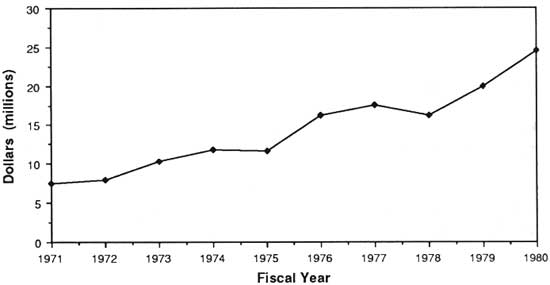
|
|
Grazing revenues 1971-1980
|
|
|
One of the last-minute compromises made to get FLPMA
passed was a requirement for BLM and the Forest Service to undertake
another study of grazing fees. In 1978, Congress legislatively set a new
grazing fee formula in the Public Rangelands Improvement Act (PRIA),
basing it on a combination of fair market value, beef prices, and
production costs. Under this formula, grazing fees rose to $2.36 per AUM
by 1980. PRIA authorized the expenditure of $365 million on rangeland
improvements over a 20-year period (in addition to the 50 percent of
grazing fee funds targeted for range improvements), but funds were never
appropriated.
|
|
|
FORESTRY
|
|
|
BLM prepared a programmatic environmental impact
statement for its forestry program in 1975. Within a year, NRDC
challenged the adequacy of BLM's statement. Settlement of the lawsuit
required the Bureau to prepare environmental impact statements on each
of 13 Sustained Yield Units in western Oregon, plus one each in northern
California and northern Idaho. Timber management plans were updated
simultaneously with the EISs starting in 1978, with the process
completed in 1983.
|
|
Timber
Management
EISs |
|
The use of pesticides and herbicides on forested
lands became a major issue for BLM in the 1970s. In June 1970, Secretary
Hickel established a policy permanently banning the use of 16 pesticides
(including DDT and 2,4,5-T) on any lands managed by the Department.
Another group of pesticides were placed on a "Restricted List," to be
used "only when nonchemical techniques have been considered and found
inadequate, and when use can be limited to small-scale applications.
|
|
Herbicides and
Pesticides |
|
In 1976, a federal court in Oregon ruled that the
Forest Service must prepare an EIS analyzing its vegetation management
practices with herbicides. Because the Bureau's program was similar, BLM
also stopped using herbicides in western Oregon until it completed an
EIS in 1979. On March 15, 1979, Secretary Andrus decided to continue the
use of herbicides in Oregon. In a memo implementing BLM's herbicide
program, however, Director Frank Gregg stated "ongoing efforts to learn
more about nonchemical methods of vegetation management...should be
continued and, I believe, stepped up so that we will become increasingly
confident and knowledgeable in their usefulness."
|
|
|
Both O&C and public domain forest management
emerged in the 1970s as multidisciplinary programs involving
coordination with recreation, wildlife, grazing, watershed, and cultural
resource programs. BLM received additional funding for inventories of
commercial forest resources outside the O&C lands. The BLM Service
Center in Denver developed a computer model for calculating allowable cuts within
sustainable harvest levels in all public domain forestry districts with
commercial timber, and each district was staffed with at least one
forester.
|
|
Public
Domain
Forestry |
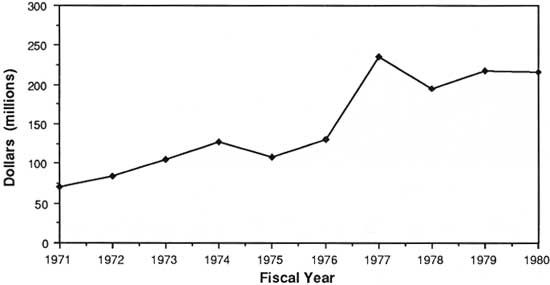
|
|
Timber revenues 1971-1980
|
|
|
While recognizing that 20 million acres of forested
lands were incapable of producing commercial sawtimber, BLM
estimated that they contained 200 million cords of wood,
or the energy equivalent of 32 billion gallons of fuel oil. Demand for
fuelwood from BLM lands for both individual consumption and commercial
resale paralleled rising energy prices. In fiscal year 1972, BLM granted
about 3,500 free use permits for fuelwood, totaling about 5
million board feet. By 1980, BLM issued 10 times as many permits for
more than 50 million board feet of wood.
|
|
Woodlands |
|
FIRE PROGRAM
|
|
|
During the 1970s, the National Park Service, Bureau
of Indian Affairs, and U.S. Fish and Wildlife Service joined BLM, the
Forest Service, and National Weather Service in supporting the Boise
Interagency Fire Center (BIFC). In 1973 the National Wildfire
Coordinating Group (NWCG) was created to develop standards for training,
equipment, and aircraft, as well as a system for determining fire
priorities. BIFC's mission evolved to provide logistical support to
ongoing fires, while NWCG worked on overall fire planning and training.
In 1974, the Forest Service's fire training center at Marana, Arizona
became interagency and national in scope.
|
|
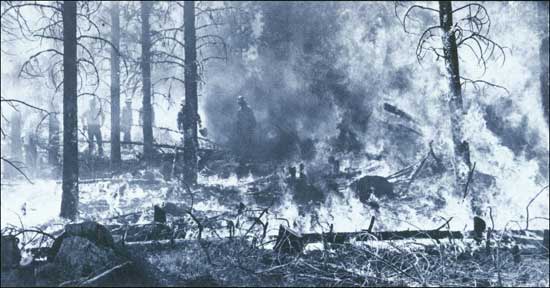
|
|
Snake River Valley crews training east of John Day, Oregon. (BLM)
|
|
|
BIFC had a major role in testing and developing
firefighting equipment, including the Bell 214 helicopter. In 1974, BIFC
tested an 8-wheel-drive all-terrain vehicle, the "dragon wagon," at
BLM's Carson City District; the experimental vehicle logged 7,000 miles
at 25 fires but proved expensive to operate and maintain. BIFC eventually acquired the
smaller and more maneuverable "Unimog" for use in fire suppression.
|
|
|
A WOMAN IN FIREFIGHTING
by Louise Power
Oregon State Office
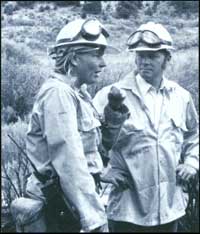
Melody Asher updates ADM Hal Bybee on status of fire.
(Louise Power)
|
"Are you here to cook?"
"Not that I know of."
"Then what are you here for?"
"To fight fire!"
This conversation was not uncommon in the mid-70s
when women first began fighting wildland fires. Prior to that time, few
if any women had been seen on the fireline.
Because few women were in the field then, separate
accommodations could not be made for such amenities as bathing.
Sometimes, to avoid putting on a show for the whole camp, many women
would bathe at mealtime—foregoing eating for bathing.
Melody Asher, a former fine arts major, is beginning
her 12th season as a firefighter, her 8th as an engine foreman. "I had
never heard of firefighting until I met Michael and that's what he did."
Michael McBride, her husband, is helitack foreman for the Ely District,
and one of Asher's staunchest supporters.
Asher is no stranger to the rigors of firefighting.
She began as the only woman on a 20-man crew with the Colorado State
Forest Service. Her first fire was, at the time, one of the largest in
the history of Colorado—more than 4,000 acres. For 9 days, the crew
dug line only to watch as the fire jumped it with whorls up to 300 feet
high. "It's really hard if you're building line 16 hours a day. At the
end of the day, your hands are just curled—they don't unbend. You
have to take one hand and unfold the other hand. And then the fire just
roars in and you have to run and sit on a knoll and watch it jump your
line." On this fire Asher learned to respect fire and the fire
organization at work.
Asher is now the ICMR (Incident Commander,
Multi-Resource) on the Ely District. She is basically the field
commander for major fires. She sizes up fires; determines what
personnel, equipment and support will be needed; directs the
firefighting operation; keeps dispatch informed of progress; and, in the
end, does the paperwork.
She has not achieved this unique position without
years of hard work and study. In addition, Asher has taken supervisory
courses culminating this past year in a situation unit leader course
which will allow her to perform on larger project fires the work she
already does on district fires.
When asked about her proudest accomplishment, she is
quick to say that it is attaining her current position. When asked why,
she answers: "I enjoy having the big fires on my shoulders."
|
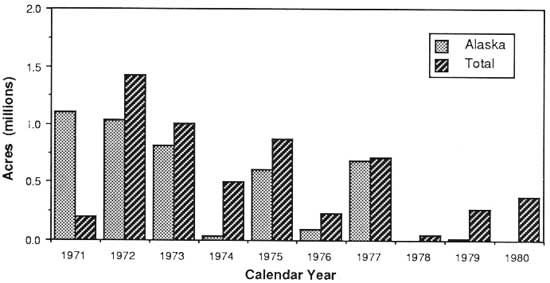
|
|
Public lands burned 1971-1980
|
|
|
The year 1977 was a big fire year. More than 10,000
fires burned over 2 million acres in the West. California's fire season
lasted from January to September, costing $400 million. BLM continued to
rely on helicopters for most of its suppression activities.
In the mid-1970s BIFC, the BLM Service Center, and
the University of Arizona developed the Automatic Lightning Detection
System (ALDS). Tested in Alaska, it was up and working in the 11
western states by 1978. The system recorded nearly every lightning bolt
striking the ground, giving fire managers an early warning system in areas with
high fire danger.
But BLM soon found itself flooded with more data than
it could handle. The Bureau then began working on a system that would
translate lightning strike information into probabilities for starting
fires and combine this with climatological information to predict which
fires were most likely to spread. BIFC and BLM field offices began using
remote automated weather stations (RAWS) to obtain meteorological
information. A new system, the Initial Attack Management System (IAMS),
integrated ALDS and RAWS data and was ready for field use by 1981.
By the late 1970s, federal land managing agencies
began to recognize the values of fire in natural ecosystems. Fire
policies began to shift from control to management: prescribed burning
came to be recognized as a management tool. In 1977, BLM's Diablo
Resource Area in California recommended the use of a controlled burn in
its Management Framework Plan to improve wildlife habitat and livestock
forage, and to reduce fire fuel accumulations adjacent to Pinnacles
National Monument. In 1979, 3,000 acres were burned in a successful test
of this management technique.
|
|
|
AUTOMATION
|
|
|
Automation has been used in the Bureau since the
mid-1950s, when the Oregon State Office leased IBM computers to develop
timber appraisals for its O&C Districts. By the mid-1970s, automated
data processing systems and equipment were in use throughout the Bureau,
making much of its work more efficient. However, few standards or
guidelines governed the use of information systems or computer equipment;
the growth of automated data processing (ADP) in BLM was at first
haphazard and unplanned. Data was rarely shared or exchanged among
systems, but BLM was beginning to recognize the need for managing its
information on a Bureauwide basis—a process begun in the 1970s at
the BLM Service Center and implemented in the field in the 1980s.
|
|
|
In 1960, automation in the Nevada State Office
consisted of a Burrough's bookkeeping machine. However, BLM soon began
to use Forest Service and Bureau of Public Roads computers to help
design roads and bridges. Most early efforts in automation involved
borrowed equipment and focused on administrative systems, but they
served to build an understanding of automation that served the Bureau
well as time went on.
|
|
Early Uses of
Automation |
|
Computers soon came to be used for cadastral survey
computations in Alaska, which led to the purchase of BLM's first
computer in 1966—one that could be hauled in a plane and used in
field camps. In 1968, a larger computer was installed in Anchorage to
support cadastral surveys and help design the Alaska pipeline. At about
the same time, BLM consolidated financial accounting in Denver,
requiring the acquisition of a mainframe computer at the Service
Center.
|
|
|
In 1976, the Service Center's Division of Standards
and Technology developed a "Strategic Plan for Information Systems," to
plan for data automation in a systematic manner. The Division started
developing a Data Element Dictionary to establish common terminology
among Bureau offices and began to look into the possibility of sharing
inventory information among natural resource programs. The strategic
plan guided the development of most automated systems in place in the
Bureau today, building a foundation for standardization and data
exchange between systems.
|
|
Information
Systems
Management |
|
In 1978 a Honeywell mainframe computer was installed
at the BLM Service Center, giving the Bureau the capabilities it needed
for agencywide communications and data base management. By July 1978,
BLM's centrally stored and processed mining claim recordation system was
operating in all BLM states except Alaska. Because of an increased
demand for automated systems by field offices, BLM installed Honeywell
minicomputers in 1979 in all of its State Offices.
|
|
|
BLM was also busy developing prototype land and
resource information systems in the 1970s. The Bureau's first automated
land records system appeared in Alaska in 1975, which served as a
precursor to today's Bureauwide Land Information System. A graphics
system for resource information analysis and display, the Map
Overlay and Statistical System (MOSS), was put together at the BLM
Service Center in 1977 for use on new Data General equipment. The
graphics system was used to help prepare the California Desert Plan, and
later to prepare a study of birds of prey in Idaho and oil shale in
Colorado. The system could create and overlay any number of resource
data themes (e.g., wildlife habitats, rivers, roads, and forested areas)
to identify potential uses and conflicts during the planning process.
Also in 1977, the Service Center added remote sensing and high-altitude
photography to the skills it provided the field.
|
|
Resource
Information
Systems |
|
CONCLUSION
|
|
|
BLM experienced its greatest growth during the 1970s.
The National Environmental Policy Act ushered in an entirely new way of
evaluating major federal actions; environmental statements and
assessments greatly increased the Bureau's workload. Wild horses and
burros on the public lands were afforded new protection, with specific
management techniques prescribed by Congress. A host of new studies and
legislation on mineral leasing; regulations on soil, air, and water
resources; and final decisions on Alaska lands significantly expanded
the Bureau's work.
New programs and employees appeared as BLM's
management responsibilities grew. Multiple use management of the public
lands was formally recognized by Congress in 1976 through passage of the
Federal Land Policy and Management Act. FLPMA repealed outdated
settlement acts and provided for the retention of most BLM lands in
federal ownership; public lands were to be managed for a variety of uses
as determined through a comprehensive land use planning system. FLPMA
also recognized areas of critical environmental concern and other lands
requiring special management and directed BLM to review its holdings for
wilderness characteristics.
BLM was now positioned to look at more efficient
management of the public lands. In the 1980s, BLM would begin to
integrate its land and mineral records with information it maintained on
natural resources, tying all this to specific locations through survey
coordinates generated from the Public Land Survey System. According to
Service Center Director Bob Moore, the development of the Bureau's Land
Information System in the 1980s would come to have the same far-reaching
effects on BLM that implementation of the Bureau's land use planning
system did in the 1970s.
|
|
Bureau of Land Management
1971-1980
|
| Employees |
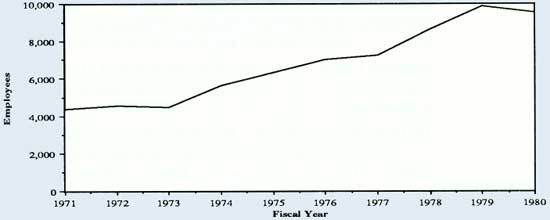 |
| Budget |
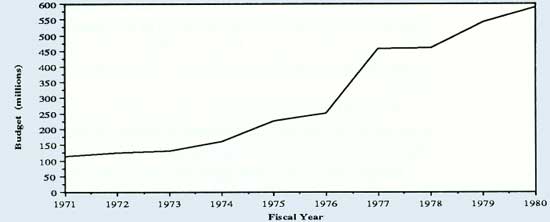 |
| Revenues |
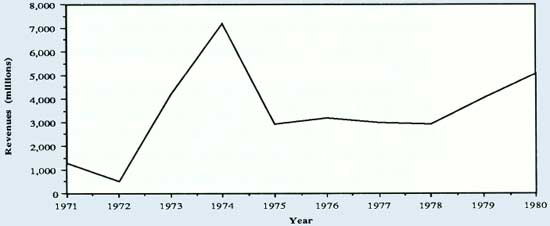 |
| Directors |
| Burton Silcock | 1971-1973 |
| Curt Berklund | 1973-1977 |
| Frank Gregg | 1978-1981 |
|
Major
Legislation |
| Alaska Native Claims Settlement Act | 1971 |
| Wild and Free Roaming Horse and Burro Act | 1971 |
| Federal Land Policy and Management Act | 1976 |
| Alaska National Interest Lands Conservation Act | 1980 |
|
|
|
|
FURTHER READINGS |
|
|
Samuel T. Dana and Sally K. Fairfax look at BLM
administration of the public lands into the late 1970s in Forest and
Range Policy: Its Development in the United States, Second Edition
(1980), as does Marion Clawson in The Federal Lands Revisited
(1983). Though it has little discussion of BLM itself, Striking A
Balance: Environment and Natural Resources Policy in the Nixon-Ford
Years (1976) by John Whitaker provides a broad-brush review of the
first half of the decade. Paul Wallace Gates in his Pressure Groups
and Recent American Land Policies (1980) is worthwhile reading. The
best focus on BLM and the public lands in the 1970s is William Wyant's
Westward in Eden (1982).
On the Federal Land Policy and Management Act of
1976, see Irving Senzel's "Genesis of a Law," in American
Forests, Vol. 84 (January and February 1978) and the 1979 Arizona Law Review
with various articles on FLPMA.
Marion Clawson's The Bureau of Land Management
(1971) provides insight into the structure and operation of the
Bureau at the beginning of the Nixon years. Better yet is Paul J. Culhane's
Public Land Politics: Interest Group Influence on the Forest Service and the Bureau
of Land Management (1981).
A compilation of articles on various aspects of
public land management is presented in the Soil Conservation Society's
National Land Use Policy: Objectives, Components, and Implementation
(1972).
Range policy and management issues are discussed in
the National Research Council and National Academy of Sciences' massive
Developing Strategies for Rangeland Management (1984). Of
particular interest in this compilation is Sally K. Fairfax's "Legal and
Political Aspects of Range Management: Summary and Recommendations" and
her "Coming of Age in the Bureau of Land Management: Range Management in
Search of a Gospel."
Elmo Richardson's BLM's Billion-Dollar
Checkerboard: Managing the O&C Lands (1980) handles O&C
issues into this decade. Stephen J. Pyne's Fire in America: A
Cultural History of Wildland and Rural Fire (1982) covers fire
program developments into the 1970s.
Mineral policy and development are taken up by Carl
Mayer and George Riley in Public Domain—Private
Dominion: A History of Public Mineral Policy in America (1985). Coal leasing
policy is handled by Robert Nelson in his The Making of Federal Coal
Policy (1983). On the problems of the 1970s energy boom, see The Angry West: A
Vulnerable Land and Its Future (1982) by Richard Lamb and Michael
McCarthy.
On the wilderness issue, Roderick Nash's
Wilderness and the American Mind (1982) is mandatory reading. The wild horse
issue is handled by Heather Smith Thomas, The Wild Horse
Controversy (1979) and Richard Symanski, Wild Horses and Sacred Cows
(1985).
Gary Stein discusses the Alaska state land selection program in
"Promised Land": A History of Alaska's Selection of Its Congressional
Land Grants (1987). See the Alaska Native Land Claims (1978)
by Robert Arnold et al. for information on the Alaska Native Claims
Settlement Act.
On the Sagebrush Rebellion, see appropriate portions of The Angry
West: A Vulnerable Land and Its Future (1982) by Richard Lamm
and Michael McCarthy and Robert Nelson's Making Sense of the
Sagebrush Rebellion: A Long Term Strategy for the Public Lands (1981).
|
|
chap4.htm
Last Updated: 08-Sep-2008
|
